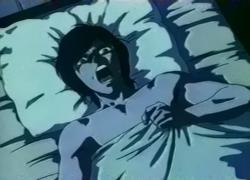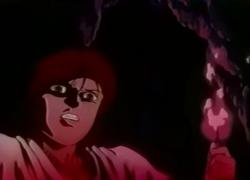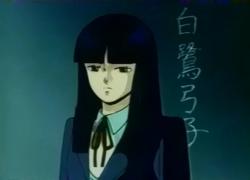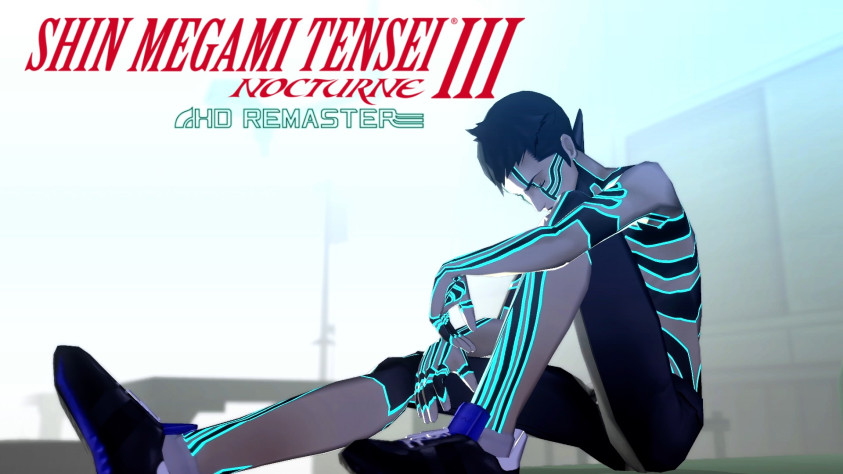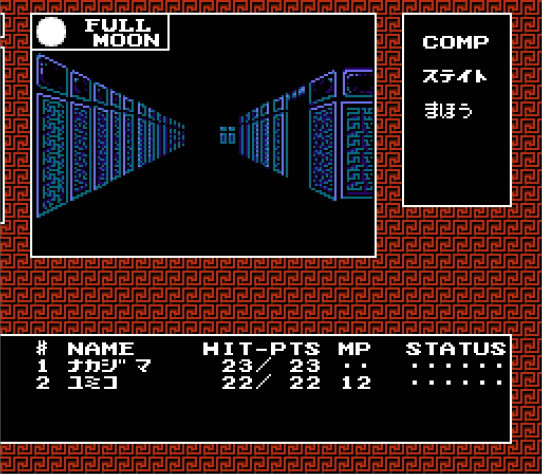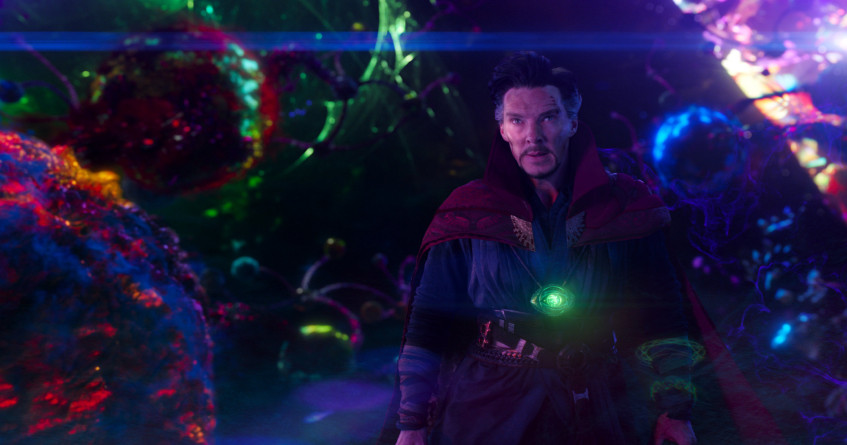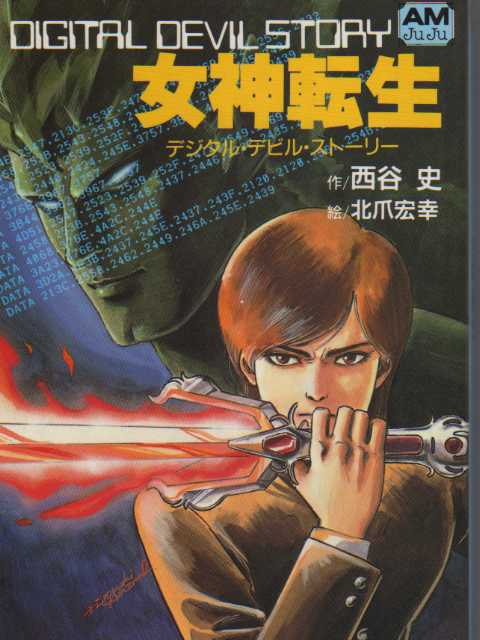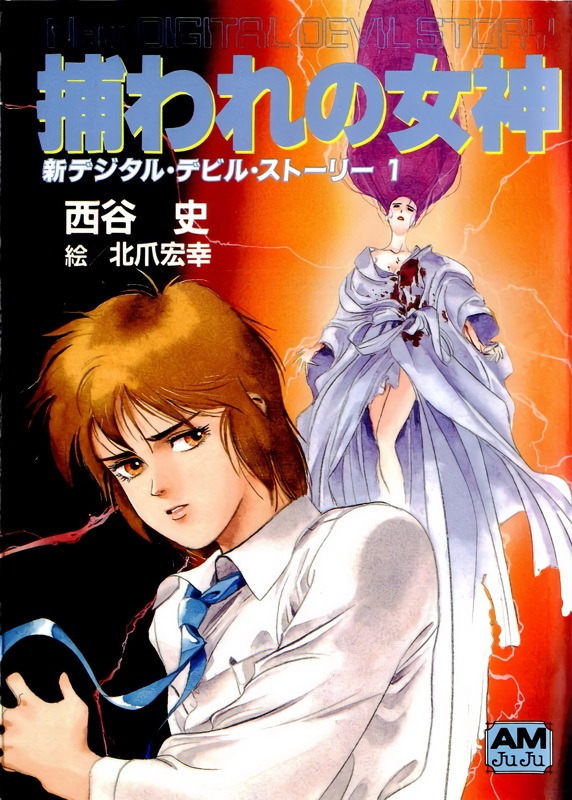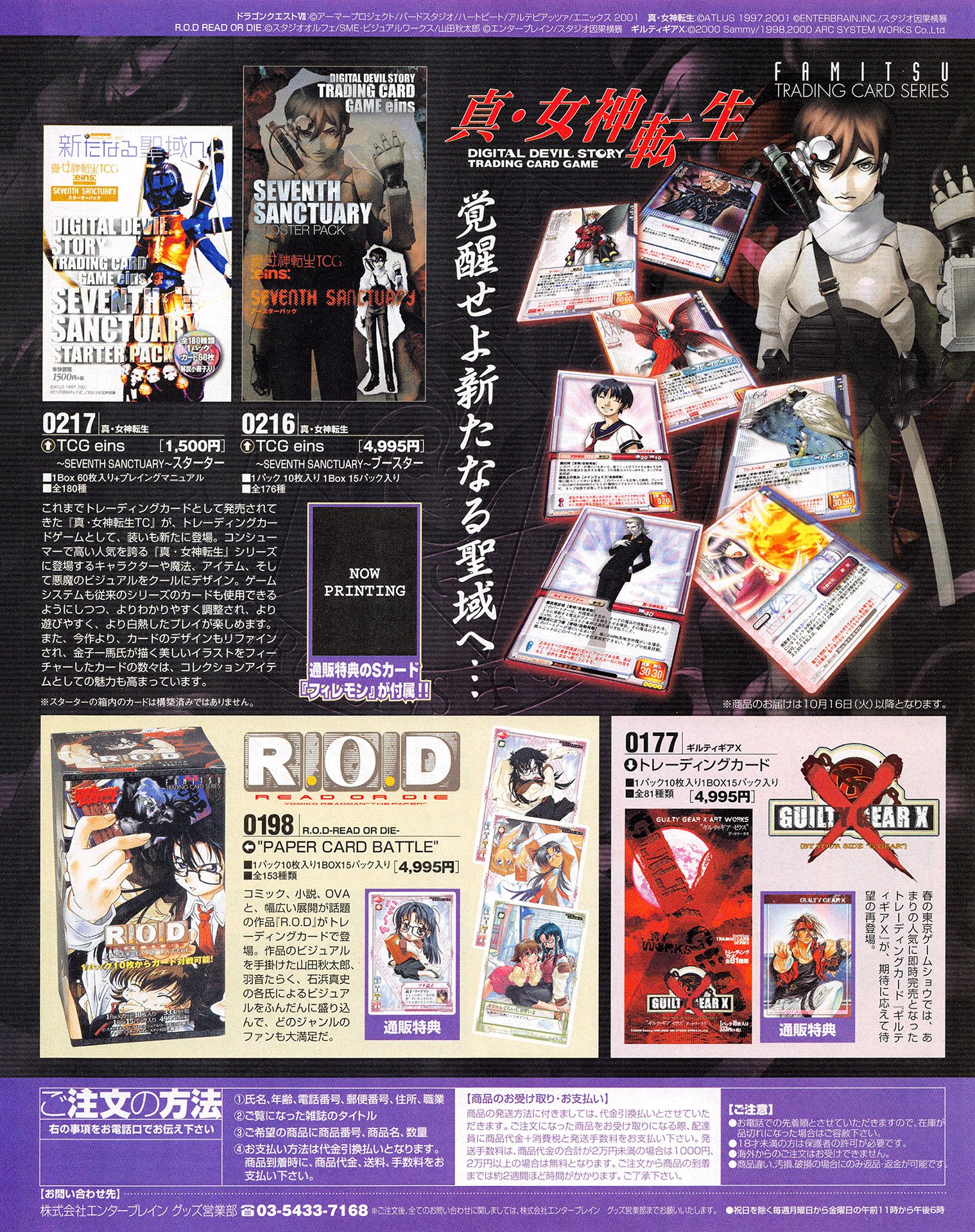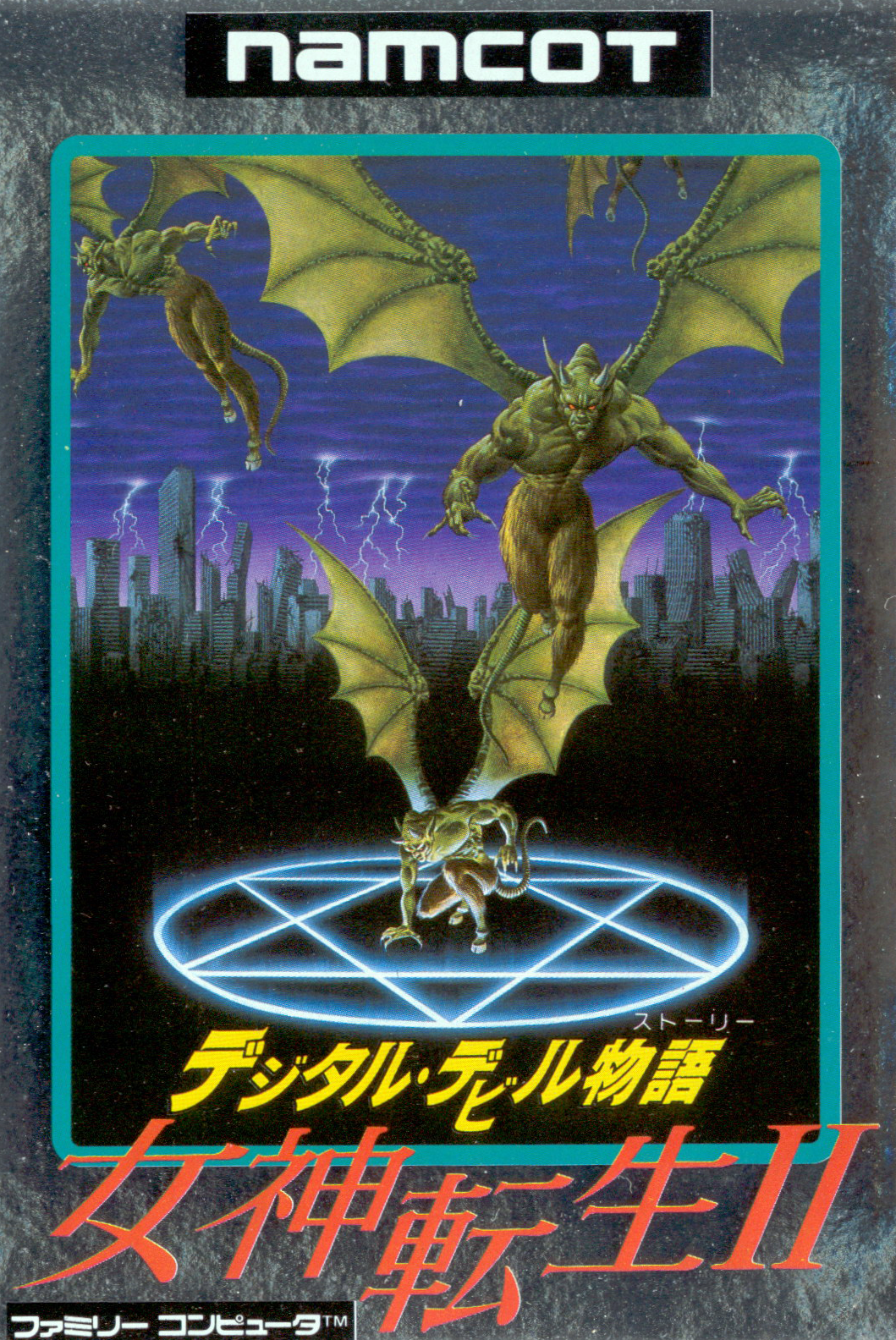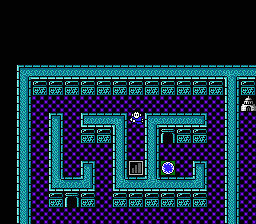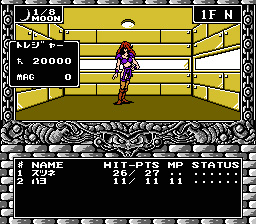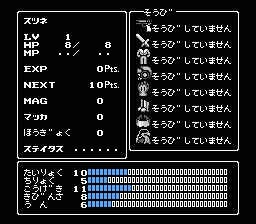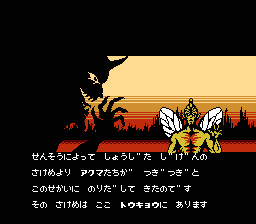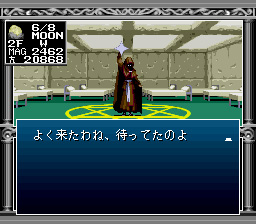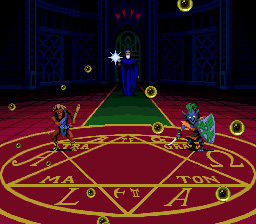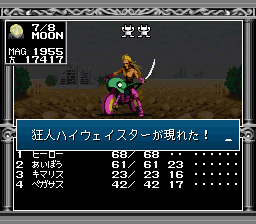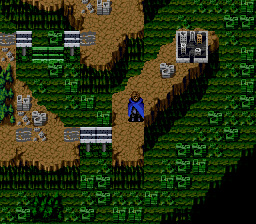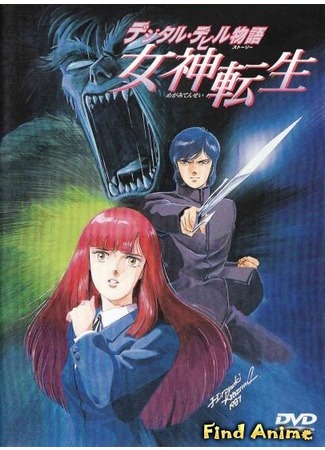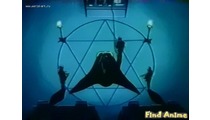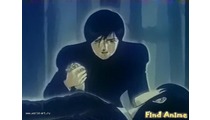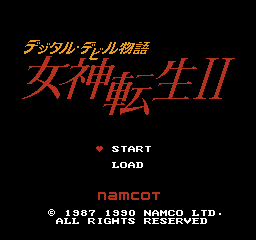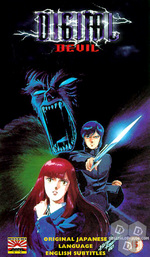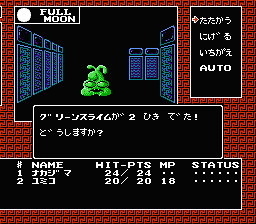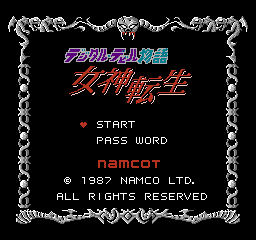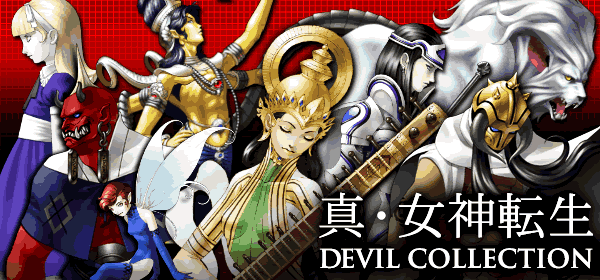Digital devil story megami tensei
Digital devil story megami tensei
Digital devil story megami tensei
Старшеклассник Акэми Накадзима – талантливый программист, однако свои дарования он употребляет самым предосудительным образом: Накадзима-кун нашел способ находить в виртуальных безднах могущественных демонов и воплощать их в реальном мире. Так, виртуальный дьявол Локи поможет ему отомстить его врагам.
. если только жестоким планам Накадзимы не помешает новая ученица, Юмико Сирасаги.
|
Мдааа уж. Ну SerpentDrake и понаписал. Не выдержал, и исправлю вышесказанное:
во-первых: это скорее экранизация трешевой новеллы Megami Tensei под авторством Ая Ниситани, по которой Namco(! ) сделала одноименную игру (чуть позднее сиквел).
во-вторых: перечисленные игры относятся к семейству Shin Megami Tensei, которые разрабатывает Atlus ( насколько мне известно по Megami Tensei они сделали всего 3 игры (Tokyo Mokushiroku, римейк 2-х первых игр от Namco и не так давно онлайновую Imagine)).
в-третьих: Persona и Digital Devil Saga у нас никто в Shin Megami Tensei не переименовывал. Более того в Японии это самостоятельные серии, но в США приписывают к их названиям Shin Megami Tensei, чтобы показать что эти игры находятся в родстве.
| +4 |  | Если Вы считаете этот комментарий полезным, то проголосуйте за него. |
Щито? Невнятный конец? По сравнению со многими аниме, вышедшими после 2005, конец вполне себе даже нормальный.
СПОЙЛЕРЫ!
Ненуачо, герои добрались-таки до мира какого-то там света (того, наверное), а во всемирной паутине сидит не один демон и сенсею пишет новый демонический мужик, а, значит, ее личная жизнь налажена. Все счастливы, все довольны.
P.S. я обалдела, когда школьницу подняли вниз головой и укусили между ног, да так что кровь аж по шее полилась. Брррр.
P.P.S. собачку жалко :С
| +3 |  | Если Вы считаете этот комментарий полезным, то проголосуйте за него. |
Странная весчь, ога. И вроде бы хочется найти что-то положительное в ней, поверить в рассказанную историю, как-то посочувствовать героям… мол, да, экранизация не очень, но… но…
Да кого я обманываю, это ужастик 80-х, он не мог быть лучше того, каким он сделан. Серьезно упрекать его в исполнении – то же самое, что корить 80-е за то, что они 80-е. Тупо, правда? Но ведь все признаки трэша на лицо, да и в 80-е было немало качественных аниме… Так что… Я не знаю, судите сами, а мне не понравилось, хотя я искренне пыталась проникнуться. Последние 10 минут так вообще съели мой мозг – что за атас творился на экране? Кто, что, зачем, почему? Есть ли у этого хоть какая-то логика, объяснит кто?
В общем, если смотреть, то ради трэша. Бессмысленного. Фильм – говно, однозначно. Мало того, что реализован паршиво, так и в идее своей весьма сомнителен (уж я не знаю, что там было в книге). Не удивляюсь, что из него выросло какое-то подобие покемонов – в самый раз.
Каково это — впервые играть в Digital Devil Story: Megami Tensei в 2020 году?
Изначально я не собирался делать ничего такого. Я не собирался играть (и уж тем более проходить) Digital Devil Story, не собирался читать оригинальную историю Аи Ниситани и не собирался смотреть аниме по нему. Хотя аниме я так и не посмотрел. Да и книгу забросил читать на втором томе. Но игру всё-таки прошёл.
Хотя, наверное, это особо и не удивительно, учитывая историю SMT: первые две части вышли в Японии на Super Famicom и на Западе не издавались, третья часть вышла на Западе, но на консоли Sony, а не Nintendo, четвёртая вышла снова на Nintendo, только не Wii U, к примеру, а на карманной 3DS (там же вышла и Apocalypse), ну и пятая должна выйти на Switch. Неслабый разброс платформ. Persona же по большей части тусовалась на консолях от Sony, что как мне кажется и сыграло некоторую роль в её популярности.
Меня же SMT всегда интересовала не меньше Персоны, возможно даже больше и это несмотря на то что она (SMT) в общем-то прошла мимо меня. В конце концов у игры даже английского названия нет, только это одно уже вызывало у меня интерес.
На момент, когда я начал эту затею, про саму книгу я не знал практически ничего. Слышал что-то про школьника призвавшего демона с помощью компьютера, про кхм-кхм. учительницу. Что книга вроде бы была популярной (хотя информацию о продажах мне найти не удалось). Что скорее всего где-то там торчат уши от Devilman. Вот вроде бы и всё. Ну и то что по мотивам книги выпустили игру конечно же. В общем читал что-то когда-то на вики, да в интернете.
Тут же мне стало интересно, а какой же могла быть такая игра, тем более ещё и выпущенная на 8-битной консоли? Конечно я мог бы просто посмотреть геймплей на Ютюбе и успокоиться. Но мне захотелось понять как именно она игралась, ведь по сути с неё началась целая франшиза, значит должно было в ней быть что-то? А при просмотре видео такие вещи хуже ощущаются. Поэтому я захотел попробовать сыграть в неё. И я пошёл гуглить. Rom игры и эмулятор само собой найти было несложно. Я запустил игру, посмотрел коротенький ролик, раскидал наугад статы и увидел это:
Я походил по коридорам, потыкался в стены и закрыл эмулятор, даже не став спускаться на следующий этаж. Где-то тут я и собирался всё закончить. Игра выглядела не очень, да и разбираться что здесь к чему мне было лень. Я стал копаться в интернете, искать информацию о книге, в общем пытался разобраться откуда у франшизы ноги растут. И мне попался её любительский перевод. Я решил его немного почитать из любопытства. Составить небольшое впечатление, так сказать. Книга, в итоге, оказалась короткой (прочёл её за пару часов) и не сказать чтобы очень хорошей. По мне так ничего такого, из-за чего стоило бы заморачиваться с созданием игры. Но тем не менее по книге ведь ещё и аниме сделали. Возможно в Японии 80-х она и правда была достаточно популярной.
Поначалу всё было неплохо: я бродил по коридорам, разбирался с монстрами, искал проходы на нижние этажи и уговаривал присоединяться демонов к партии. И это, кстати, одна из важных особенностей игры. Поскольку основная партия состоит только из двух человек, увеличивать её размер можно только за счёт призванных демонов. В игре большинство встречаемых врагов можно завербовать в свою группу. Для этого нужно начать с ним разговор, но это возможно только если демон остался один. С группой демонов договориться не выйдет, соответственно нужно будет уничтожить всех кроме одного. Проще всего когда нападает только один демон, тогда можно начинать «вербовку» сразу же. Заниматься этим мне в целом понравилось. Цель состоит в том, что нужно определить последовательность ответов, при которой «переговоры» закончатся удачно. Иногда демон может отказаться говорить, иногда просто убежать, иногда попросить деньги или магицит и убежать, или даже напасть, но если повезёт и «переговоры» пройдут успешно, то он присоединится к вашей партии. Хотя есть и такие которых завербовать нельзя вообще, но по ощущениям их меньше.
В общем, пройти до конца игры не набирая демонов в партию будет довольно сложно, даже скорее всего невозможно. И, забегая вперёд, скажу, что делать игру сложнее, чем она уже есть, вам вряд ли захочется.
Но как я и сказал, сначала играть было довольно просто и я даже втянулся. Хотя всё-таки одна ложка дёгтя на тот момент уже была. А именно: в игре нельзя сохраняться. Нигде. Ни. Одного. Сейвпойнта.
И при такой системе меньше переживаешь когда наступает Game Over. Это же немного помогает на начальных этапах, в прокачке уровня. Так же помогает в прокачке и то что погибший сопартиец всё равно продолжает получать опыт. Жаль что в других JRPG такую систему не применяют. В общем это я тоже могу занести в плюсы.
Sky City, кстати, не единственный «город» в этой пирамиде. Хотя, наверное, правильнее назвать их «поселениями» Всего их где-то штуки три. И названия их я уже даже и не помню. Обычно это поселения, в котором сидит торговец, иногда с лекарем, и может пару NPC торчат на уровне, но поскольку торговцы и тем более NPC могут иногда сидеть просто посреди буквально ничего, то я так и не понял чем именно эти «города» отличаются от остального лабиринта. Просто какая-то локация называется «городом», а какуя-то нет.
Digital Devil Story: Megami Tensei
Original Novel Cover
Contents
Characters [ ]
Chapter List [ ]
Summary [ ]
In Jusho High School, there is a divide among the student body; those of the gifted side and those of the normal side. Students in the gifted class are normally exceedingly intelligent, while those in the normal class tend to be academic under-achievers.
Akemi Nakajima, of the school’s gifted class and a computer genius, is assaulted by Hiroyuki Kondo of the normal class under the orders of Kyoko Takamizawa, who had been angered by Nakajima rejecting her romantic advances. Kyoko had told Kondo that Nakajima had been flirting with her rather than the other way around, prompting the attack.
The normal students were rarely punished for their actions against other students out of fear and pity on the part of faculty. Battered and bloody, Nakajima comes home and decides to finish his Demon Summoning Program, a work in progress of his, to exact revenge. He discovers that his computer is not powerful enough to use the program, so he must use the school’s Computer Aided Instruction (CAI) room’s host computer.
Sneaking into the school at night, Nakajima draws a pentagram in the computer room and attempts to run the program, but is found by Professor Iida. Nakajima has a tense conversation with the professor, who becomes afraid of him, but he is able to run the program regardless. Nakajima commands the program to kill Kondo and Kyoko, which causes a tremor in the school but otherwise appears to not work.
A week later while Professor Iida is teaching a computer class in the CAI room with Nakajima and Kyoko present. Suddenly a voice resounds from the host computer. A demon, Loki, trapped inside the host computer, uses the monitors in the CAI room to hypnotize the entire class except Nakajima, Kyoko and Professor Iida. The demon follows Nakajima’s request and commands the hypnotized students to kill Kyoko. They then lure Hiroyuki Kondo, into the room and kill him as well. Professor Iida is also killed in the chaos, which upsets Nakajima somewhat: Loki had followed the program’s command, but Nakajima had not specified any restrictions.
Drunk with power, Nakajima at first begins to comply with Loki’s request for female sacrifices, offering him his female professor, Ohara, who proceeds to be metaphysically assaulted by Loki through the use of a helmet-like contraption connected to the summoning program. Permanently damaged by the encounter, Ohara eventually becomes Loki’s loyal servant and helps Loki assume physical form in the human world through Nakajima’s program as well as her own connection to the demon.
Nakajima meets Yumiko Shirasagi during this time, a newly-transferred student with whom he feels a strange connection to. Unbeknownst to him, she had witnessed the bizarre encounter with Ohara and Loki, but had dismissed it as illusion and trickery. Eventually, the demon demands that Nakajima offer him Yumiko, which Nakajima refuses to do. He then advises Yumiko to stay away from the school in an attempt to save her. That night, Yumiko ignores Nakajima’s advice and returns to the school, prompting the attention of Loki. Nakajima attempts to regain control of Loki, but the demon mocks Nakajima’s attempts to command him.
Loki summons himself into the physical world through the CAI room computer and goes on a killing spree, free from Nakajima’s control. Jealous of Yumiko, Ohara attacks and wounds her. Nakajima summons a benign, loyal demon, Cerberus, to help him battle Loki, to no avail. During the battle, Yumiko is possessed by Izanami, of whom Yumiko is a reincarnation, and burns Loki with her powers. In addition to dealing with Cerberus, Loki is distracted enough so that Yumiko and Nakajima can escape through a dimensional warp to Asuka created by Izanami, although Loki succeeds in fatally wounding Yumiko as she flees.
Still influenced by Izanami, Yumiko tells Nakajima that she will die, but could be revived if her body is brought to Izanami’s tomb. Yumiko dies, but with the help of Cerberus, Nakajima complies with her dying request and travels to the Shirasagi Mount, where he meets Yomotsu-Shikome, a loyal servant of Izanami’s.
Yomotsu-Shikome provides Nakajima with two mystical spheres, and guides him onward. With Ohara’s help, Loki is able to follow them to Asuka and Shirasagi Mount, where he kills Yomotsu-Shikome. Izanami meets Nakajima and Yumiko in the tomb, but she is attacked by Loki before the resurrection can take place. Nakajima summons Cerberus to help, but his companion is also no match for Loki, and is defeated. Desperate, Nakajima uses the two spheres that Yomotu-Shikome gave him, which ignite the pomade-covered floor of the tomb, summoning Hinokagutsuchi, who in turn transforms into a powerful, mystical fire sword, with which Nakajima is at last able to kill Loki. Izanami succeeds in reviving Yumiko, but keeps her with her, stating that Yumiko has great hidden powers within her with which they could battle evil.
Meanwhile, Ohara, impregnated by Loki, attempts to communicate with him, not knowing that he has perished. This makes her accidentally contact the demon Seth.
New Digital Devil Story: Goddess of Enchainment
Original Novel Cover
Contents
Characters [ ]
Chapter List [ ]
Summary [ ]
Year 199X. After the death of Akemi Nakajima, Japan was still under control of Lucifer. The Devil lived in a Liberated Area, which was isolated from the general public, apparently Akemi Nakajima said, that there was no demons left in this world.
Izanami, who used the body of Shirasagi Yumiko as a temporary lodging, fought against the demons at Suwa, but was defeated.
Izanami breathes back due to the anti-soul magic. However, it was not the goddess Izanami but the person Yumiko Shirasagi herself. Like a sleepwalker, Yumiko continues to follow the illusion of Nakajima.
It’s been a year since then. April.
One day, Asuka’s classmate Reiko Kido got in touch with him.
Even if the devil has the appearance of a normal human, it emits a wave called an X wave during metabolism. Very few people have the ability to see it and see what it is. Asuka was one of those people.
Asuka was having a delicate interval, but without being able to listen to the detailed story, on a frustrating night, Asuka had a mysterious dream. A dream that he’s a baby and Yumiko Shirasagi is his mother. And the face of the man who called Yumiko Izanami was like that of Akemi Nakajima.
An official of the Ministry of Security and Autonomous Affairs visited Tosei High School and was carrying out a curriculum called a circuit lecture to hunt those with supernatural abilities and those with anti-governmental thought. Students monitor their brain waves with the latest audiovisual system (a system that converts digital signals into brain waves to realize virtual reality).
Reiko, who had been spotted by the anti-government organization «Crusader,» was found to be a capable person in this investigation and was attempted to be taken to security police. Asuka helps Reiko to escape from that.
Reiko revealed that she was a member of the Pope’s Office of the Depressed Crusade of Tokyo, which the security police had seen as an enemy.
Asuka decided to sneak into the special ward along with Reiko and Father Costa. However, as soon as he entered the special ward, he was surrounded by the security police who were waiting for him.
Asuka, Reiko, and Father Costa were captivated by a lawless city known as the Liberty Zone. A mysterious surveillance robot, a town where murder has turned into a Fiesta that cannot be understood.
For the time being, he hired Kirara, a young boy who helped him, and although it was inconvenient, he began to explore Yumiko Shirasagi as he originally intended.
On the first night of the special ward, Asuka has a mysterious dream again. I am angry with my father who has the face of Nakajima. And the girl who calls herself Susanoo.
Asuka and others meet a man named Tashiro with information about Yakumo.
He was the founder of the Church of St. Sirens. When he witnessed the scene where Yumiko Shirasagi reincarnated the god, he regretted his deeds until now without a cult, and continued religious activities with the doctrine of waiting for the next reincarnation by suicide.
Yakumo helped Asuka and Father Costa by sending Reiko to the ruler of the special ward, Bathory. She was a legendary female vampire. He sacrificed one Reiko to help them.
Of course Asuka could not accept that. Asuka, Father Costa, Tashiro, and Kirara infiltrated the ward to rescue Reiko from the mansion of Bathory, and to help Yumiko, who is believed to be caught.
When he found Reiko who was about to be tortured, the power that inherited the trait of Asuka’s Susanoo who was angry was released. Asuka helps Reiko and defeats the devil with tremendous power.
Finally, he arrived at the captured goddess. However, what the group saw was the figure of Shirasagi Yumiko, who was disheartened by the real-life holographic image of Akemi Nakajima.
In a moment, Yumiko burned out Tashiro, who desperately tried to persuade her to recover her sanity.
When the power of the mighty goddess had no control, the God of Taniguku finally arrived from Suwa to the special ward. And by making full use of anti-soul techniques, he succeeds in having the holographic possession of Akemi Nakajima’s soul.
The art of anti-soul of Taniguku collapses.
Yumiko, who lost Nakajima in front of her twice, flew away into the sky with a scream of despair.
Shin Megami Tensei: Digital Devil Story (Card Game)
The Shin Megami Tensei: Digital Devil Story Card Game, commonly referred to as the Digital Devil Story Card Game, is a TCG based on the Megami Tensei franchise.
Contents
Profile [ ]
The Shin Megami Tensei Trading Card Game can be divided into two distinct «versions», the original produced by Enterbrain between 1997 and 2003, and the «Nocturne» version produced by Media Factory starting in 2003. The two versions have several notable gameplay differences and as such the Media Factory game cannot be considered a continuation of the Enterbrain game.
The Enterbrain game consists of nine editions:
Gameplay [ ]
The players are Devil Summoners, with 200 hit points each. The object of the game is to reduce the opponent’s HP to 0. Each player has two decks of 60 cards each.
Cards [ ]
There are four types of cards.
Magnetite is required for summoning demons, using items, and using magic. Magnetite can be released from Nakama and Partner cards, but there are five attributes, which are LIGHT, DARK, LAW, CHAOS, and NEUTRAL. However, apart from NEUTRAL, the Magnetite attribute must match the attribute of the Nakama and Partner Cards.
Digital Devil Story: Megami Tensei
Из Википедии — свободной энциклопедии

Обложка версии для PC-88
Telenet Japan (PC)
Opera House (SFС)
Telenet Japan (PC)
Atlus (SFС)
16-мегабитный картридж для Super Famicom
Digital Devil Story: Megami Tensei (яп. デジタル・デビル物語 女神転生 Dejitaru Debiru Monogatari Megamitenshō) — видеоигра в жанре RPG, основанная на трилогии научно-фантастических романов японского автора Ая Ниситани. Первая версия игры была разработана Atlus и выпущена Namco в 1987 году для Famicom. Версия для персональных компьютеров была разработана совместными усилиями Atlus и Telenet Japan и выпущена Telenet Japan в том же году. Улучшенный порт для Super Famicom от Opera House был выпущен в 1995 году.
История повествует о японских старшеклассниках Акэми Накадзима и Юмико Сирасаги, сражающихся с силами Люцифера высвобожденными программой призыва демонов, созданной Накадзимой. Игровой процесс включает в себя изучение подземелий от первого лица, пошаговые сражения и диалоги с демонами, а также путешествие по враждебному лабиринту Накадзима в версии для Famicom, сражения в котором происходят в реальном времени в версии для PC.
Разработка обеих версий игры началась после выпуска оригинальной анимационной адаптации первой книги Ниситани Digital Devil Story в начале 1987 года. Ниситани был глубоко вовлечен в дизайн и сценарий. Механика игрового процесса была основана на серии игр Wizardry, но с добавленной системой диалогов с демонами, считавшейся революционной для того времени. Atlus и Telenet Japan работали над своими проектами одновременно, играя против жанровых стереотипов своих платформ. Версия для Famicom оказалась более популярной среди критиков и геймеров, породив продолжение под названием Digital Devil Story: Megami Tensei II в 1990 году.
From Wikipedia, the free encyclopedia
Tell your friends about Wikiwand!
Gmail Facebook Twitter Link
Suggest as cover photo
Would you like to suggest this photo as the cover photo for this article?
Thank you for helping!
Your input will affect cover photo selection, along with input from other users.
Thanks for reporting this video!
This browser is not supported by Wikiwand 🙁
Wikiwand requires a browser with modern capabilities in order to provide you with the best reading experience.
Please download and use one of the following browsers:
An extension you use may be preventing Wikiwand articles from loading properly.
If you’re using HTTPS Everywhere or you’re unable to access any article on Wikiwand, please consider switching to HTTPS (https://www.wikiwand.com).
An extension you use may be preventing Wikiwand articles from loading properly.
If you are using an Ad-Blocker, it might have mistakenly blocked our content. You will need to temporarily disable your Ad-blocker to view this page.
Digital devil story megami tensei
Digital Devil Monogatari: Megami Tensei II (NES)

Регион: NTSC|J 
Жанр: JRPG
Разработчик: ATLUS
Издатель: Namco
Платформа: Nintendo Entertainment System
Медиа-формат: 1 CARTRIDGE
Дата выхода: 06.04.1990

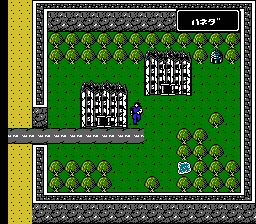
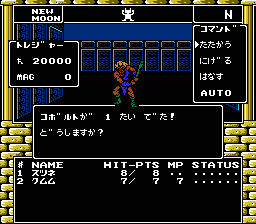
Kyuuyaku Megami Tensei (SNES)

Регион: NTSC|J 
Жанр: JRPG
Разработчик: ATLUS
Издатель: ATLUS
Платформа: Super Nintendo Entertainment System
Медиа-формат: 1 CARTRIDGE
Дата выхода: 31.03.1995
Данный римейк является одной из двух игр, входящих в Kyuuyaku Megami Tensei. Полностью перерисована вся графика и повышено качество звучания. Как и в SMT II, в игру добавлены мини-игры (игровые автоматы и прочее), где на выигранные очки вы можете приобрести различные предметы. Так же немного изменена структура локаций (к примеру, если раньше за NPC был проход, то теперь вы увидите просто стену).
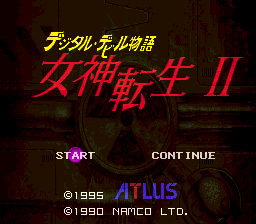

После игровой адаптации книги Ниситани Айи (Digital Devil Story: Megami Tensei), молодая и перспективная компания ATLUS, под издательским крылом Namco решает выпустить следующую игру за номером два, решившись сделать уже нечто своё, не опирающееся на творчество писателя или кого бы то ни было. Megami Tensei II родилась пост-апокалиптической ролевой игрой с упором на «демоническую» составляющую, тем самым заложив фундамент целой серии игр. Не смотря на довольно интересную игровую концепцию, игра не снискала больших продаж и проиграла своему конкуренту в лице FF III, но, тем не менее, начало было положено..
Сюжет : В 199Х году человеческой цивилизации пришел конец. Нескончаемые боевые действия и атомные бомбардировки заставили людей укрыться глубоко под землей, в бункерах, каждому из которых присваивался порядковый номер. Действие разворачивается в 2036 году, в бункере за номером 3 (об этом свидетельствуют и нашивки на одежде главных персонажей), где вы проводите время за игрой, именуемой «Devil Busters» (эдакий аналог «Megami Tensei»). В конце этой игры вы встречаете демона Пазузу, посланника Бога, которого запер в игре маг Баэль, дабы не дать свершиться замыслам Бога по спасению человечества. Тем не менее вы спасаете Пазузу от сетевого заточения и он рассказывает вам правду о появившихся демонах (бомбардировки вызвали выброс энергии, в результате которого открылся проход между миром людей и демонов) и о том, что вы являетесь Мессией, способным спасти человечество от погибели и порабощения демонами. Выйдя из игры, два друга замечают, что бункер был взят штурмом неким некромансером и его упырями, разбомбившими всё вокруг и наводящими ужас на окружающих. Получив поручение от божьего посланника и спася свой бункер, вы выходите наружу, отправляясь в путешествие по разрушенному Токио, идя навстречу судьбе, ради светлого будущего Земли.
Игровой процесс : Хотя структура игры образца первой части и осталась нетронутой, теперь она радует одной очень приятной особенностью – «картой мира», где мы перемещаем нашего анимированного человечка по разрушенному миру, забегая из района в район в поисках нового сюжетного события, попутно сражаясь с демонами на карте. Вы также можете скрещивать демонов, выводя всё более сокрушительных и удароустойчивых демонов. Помимо того, что скрестить можно и сразу троих, вы можете на том же месте (Собор Теней) избавиться от негативных статусов, заплатив хранителю обиталища. Теперь вместо паролей, запоминающих ваше местоположение, сделали возможность сохранения игры: достаточно пройти к ближайшему терминалу и выбрать пункт сохранения. Вы также можете мгновенно переноситься от одного терминала к другому, что упрощает передвижение по огромной карте. В игре вы будете много общаться с различными NPC, и в важных игровых событиях вам придется сделать тот или иной выбор, который в конце выльется в одну из двух концовок. Честного говоря, практика игры в ранние мегатены показывает, что бои не сколько сложны (хотя порой вас «наказывают» очень хорошо), сколько занудны в плане появления врагов (появляются они чуть ли не через каждый сделанный вами шаг).
Звук : Типичное восьмибитное звучание, которое хорошо вписывается в общую игровую обстановку. Итогом всех стараний композитора стал саундтрек, включающий в себя темы из первой и второй части, а также аранжировки, выполненные в современном роковом стиле. Композитором является Цукаса Масуко, отец всея OST’ов ранних мегатенов.
АВТОР: DEADALUS
ПОД РЕДАКЦИЕЙ: CITIZEN ZERO
ПЕРЕИЗДАНИЕ НА NTT DoCoMo FOMA
К сожалению о данном римейке мало что известно, за исключением похорошевшей отчасти графики (странно, но в этом переиздании карта выглядит на уровне NES, благо сами локации чем-то похожи на PS переиздания SMT I и II). Как видим, вернулись крупные портреты персонажей, которые отсутствовали в SNES переиздании.
Digital Devil Saga: Avatar Tuner
Содержание
Сюжет
На планете, именуемой «Свалка» несколько племён увязли в междоусобной войне. Лидер племени Эмбрион Сёрф и его отряд, вступают в битву с вражеским племенем Авангард. Причиной конфликта стал неизвестный объект, напоминающих яйцо. Вскоре, объект начинает светиться, обе стороны конфликта пытаются убедить друг друга ликвидировать его. После внезапной вспышки света, племена обращаются в ужасающих демонов. Спустя некоторое время, Сёрф просыпается и видит, что большая часть врагов выпотрошена. В кратере, образовавшемся в результате взрыва, отряд находит загадочную, спящую девочку. После этого, власти Свалки озвучивают новое правило: то племя, что приведёт черноволосую девочку и уничтожит другие племена, будет допущено в Нирвану. Игроку предстоит узнать тайны загадочной девочки, новых способностей и Нирваны, которая приведёт всех в рай.
Персонажи
Игровой процесс
В отличии от игр серии Shin Megami Tensei, все сопартийцы играют важную роль в истории и имеют две формы, человеческую и демоническую. Демоны, которые противостоят группе, не могут быть завербованы или получены путём слияния. Однако, появляются навыки «Охоты», с помощью которых отряд может поглотить обычных врагов для получения большего кол-ва очков Атмы.
Так как игрок не может подвергать демонов слиянию, для развития персонажей используется система «Мантра». Используя Атма-очки, полученные за поглощенных врагов, игрок вкладывает очки в Мантры, чтобы получить новые умения. Каждый персонаж может запомнить все умения и Мантры, но иметь можно лишь несколько навыков.
Digital Devil Story: Megami Tensei
From Wikipedia, the free encyclopedia
Digital Devil Story: Megami Tensei [a] refers to two distinct role-playing video games based on a trilogy of science fantasy novels by Japanese author Aya Nishitani. One version was developed by Atlus and published by Namco in 1987 for the Famicom—Atlus would go on to create further games in the Megami Tensei franchise. A separate version for personal computers was co-developed by Atlus and Telenet Japan and published by Telenet Japan during the same year. An enhanced port for the Super Famicom by Opera House was released in 1995.
The story sees Japanese high school students Akemi Nakajima and Yumiko Shirasagi combat the forces of Lucifer, unleashed by a demon summoning program created by Nakajima. The gameplay features first-person dungeon crawling and turn-based battles or negotiation with demons in the Famicom version, and a journey through a hostile labyrinth as Nakajima featuring real-time combat in the Telenet version.
Development on both versions of the video game began as part of a multimedia expansion of Nishitani’s book series. Nishitani was deeply involved with the design and scenario. The gameplay mechanics in Atlus’ role-playing version of the game were based on the Wizardry series, but with an added demon negotiation system considered revolutionary for the time. Atlus and Telenet Japan worked on their projects simultaneously, playing against genre expectations for their respective platforms. The Famicom version proved the more popular with both critics and players, leading to the development of the 1990 sequel Digital Devil Story: Megami Tensei II.
Полнометражка Повесть о цифровом дьяволе | Digital Devil Monogatari Megami Tensei онлайн
Пользовательские оценки
Общая оценка
Сюжет
Персонажи
Если не работает, попробуйте выключить AdBlock
Ожидание ответа от сервера
Информация об аниме
Продолжительность : 45 мин.
А после школы несколько школьников, и среди них Накадзима, пытаются вызвать дьявола. Накадзима призывает Локи, заключает его в компьютерном мониторе и приносит ему в жертву женщину. Что же станет с Юмико, ставшей свидетельницей этой сцены?
Кадры
Смотреть полнометражное аниме Повесть о цифровом дьяволе онлайн
Если не работает, попробуйте выключить AdBlock
Ожидание ответа от сервера
3×3 Eyes: Immortals
3×3 глаза
Если не работает, попробуйте выключить AdBlock
Ожидание ответа от сервера
3×3 Eyes: Legend of the Divine Demon
3х3 глаза: Сказание Сэймы
Если не работает, попробуйте выключить AdBlock
Ожидание ответа от сервера
Aguu: Genius Dolls
Агу: Гениальные куклы
Если не работает, попробуйте выключить AdBlock
Ожидание ответа от сервера
Hell Girl
Адская девочка [TV-1]
Если не работает, попробуйте выключить AdBlock
Ожидание ответа от сервера
Hell Girl: Three Vessels
Адская девочка [TV-3]
Если не работает, попробуйте выключить AdBlock
Ожидание ответа от сервера
Hell Girl: Two Mirrors
Адская девочка: Два Заключенных [TV-2]
Если не работает, попробуйте выключить AdBlock
Digital Devil Story: Megami Tensei II
The first game in the Megami Tensei series to not be based on a novel, Digital Devil Story: Megami Tensei II is set 35 years after the nuclear-tipped end of civilization as we know it, when Pazuzu inexplicably declares a pair of nerds playing JRPGs in their bunker the saviors of mankind, gives them the ability to chat up demons and sends them out into the Capitol Wasteland to salvage what’s left of mankind.
Содержание
Sub-Page
Hidden Text
A message from the game’s programmer is copied to RAM and used to check for a soft reset.
«COZY» refers to the series producer Koji Okada.
Startup Check
Each time the game is started, it checks for the presence of a certain value in SRAM memory. When uninitialized (i.e. the cartridge is started for the very first time, or the back-up battery is changed), an animated «DDSII» logo is shown before the normal intro. This logo won’t be shown if the SRAM is already initialized.
In addition, the game checks for the presence of a specific peripheral in the Famicom’s expansion port. This peripheral is expected to wait for one bit written to the expansion port and return it into the data bit of the expansion port inverted. Test routine is sending data of itself, just using the one lowest bit of each opcode byte. If all $46 bits are read correctly, then the routine goes to the SRAM test routines. It’s just like a self-test cheat, but using a special device instead of button codes.
The SRAM test routine first checks if SRAM contains a specific data pattern (A[i] = (A[i-1] * 5) & 0xff, A[0] = 0xAA) throughout the whole SRAM area. If the data pattern is exactly the same, the screen color will change to blue. If the test routine detects that there is no default pattern in SRAM, it rewrites it, then checks it again, so as to verify the SRAM consistency. If the SRAM is OK, then the screen color will change to pink. If these two tests fail, then the color will change to red. The test routine always kills the SRAM data, so this can be used for test purposes only.
Independent of the test results, the test routine will always go into an infinite loop with the one single sound tone, while the color is representing test results. You can exit this test only if you remove the special peripheral from the expansion port and then reset the console again. These routines were probably used in the duplication plant before releasing the cartridges, as a quick test for SRAM consistency. Obviously, if you run these tests and kill all the SRAM data, the DDSII logo will appear again before SRAM reinitialization.
Enemies Watch
After the game’s ending sequence (which shows you all of the bosses/places you’ve encountered during the game), the «END» screen will appear and loop. But if you press and hold Up + Left + A + B or Up + Right + A + B on the second controller and Up + Left + A + B + Select + Start or Up + Right + A + B + Select + Start on the first controller at the same time, the «END» screen will disappear and you will see all the enemies/bosses/monsters and demons with their names, levels and HP/MP stats. All monsters are sorted by classes and by the levels from higher to lower ones.


After all monsters are displayed, a «DDSII» logo will continuously flash on the screen, each roll changing colors from the whole color palette.
Remaining Debug Functions?
Holding the B button on controller 2 can do many things at certain points of the game, as a sort of debug toggle. A lot of it seems to have been cut but there is still quite a few things it reacts to. A majority of these are in the game’s intro, but other menus suggest that extended functionality existed at other points.
Debugging Error Feature

If you step on certain tiles out of bounds in mazes or on overworlds, this thing appears.
First row first number: Y coord (maze) ( $042F )
First row second number: X coord (maze) ( $0430 )
Second row first number: Y coord ( $0431 )
Second row second number: X coord ( $0432 )
Third row: Current tile type ( $040C )
Unused Enemies
Discuss ideas and findings on the talk page.
Specifically: This enemy could possibly just be an extremely rare encounter like Jashin Set, but rare encounters in DDS2 are just as ridiculously rare as the Majin encounters in SMT1 and i don’t have the patience to find out.
Jashin Chronos

Jaki Azezal

Kyoujin Doctor Bakuta

In a normal game, this crazed cybernetic scientist can be found underneath Kouraquen. However, in the final he is always a good guy despite his threats; at no point can you actually fight him no matter what you say to him. However, he does have a monster entry and you can even fight him if hacked into a battle. His combat capability is pretty simple, though.
Unused Overworld Tile Effects
Sleep
This effect can be seen by changing the address $040C:$0A and walking around. When walking some of your party members will eventually fall asleep; this coding appears incomplete as it will always report the status of the last monster on the character list (enabled or not) falling asleep, regardless of who actually falls asleep.
| Text | Translation |
|---|---|
| アクマは ねむってしまった | (Demon) fell asleep. |
The effect was probably going to be used for the field of flowers in the «Forest of Confusion» area in Makai, which has flowers that put your group to sleep in a cutscene.
Strong Damage
Can be seen by changing the address $040C:$0B and walking around. The effect is identical to the strong damage tiles seen in some late-game dungeons.
Unused Events
Mesian Woman
This Mesian (?) woman has no dialogue whatsoever and no flags are ever checked within her scene, which immediately exits as soon as it is displayed.. She is entirely unused, and whatever she was supposed to be used for is unknown. Her scene uses song 20 (index $14 ) in the NSF, which is the standard song for the Healer.
It should be noted that the graphics used in this scene are entirely unique to this room and event, so whatever she was planned for must have been important.
To see this event, freeze RAM address $0402 to $36 and enter any indoor building (i.e. one that isn’t a maze entrance).
Dark Hero


This is the Dark Hero who left you earlier in the game to ally with Pazuzu. His dialogue explains that Satan revived him in order to stop you. He then sends Jaki Azezal, Kaijuu Tiamat, and Jashin Belphegor before fighting you himself as Dark Hero. Stats are high, equivalent to the end of the game, and the fact Satan is referred to strictly places this at the game’s final dungeon.
The problem with this scene is, Dark Hero dies after fighting Bael earlier in the game and redeems himself, telling the player you were right in your beliefs about Pazuzu etc. In addition, this happens regardless of the minor ways you can alter the storyline. This would seem to make this cutscene a completely scrapped scenario from earlier in development!
Dialogue Translation
| Text | Translation |
|---|---|
| よくきたな | You made it. Well done. |
| おどるいて こえも でないようだな | So surprised we can’t even talk, are we? |
| オレは サタンさまに いきかえらせて もらったのさ! | Yes, I coerced Lord Satan into reviving me! |
| どうやら サタンさまを たおしに きたみたいだが | It seems you’re here to defeat Satan. But. |
| そうはさせん! | I will not let you! |
| いでよ アクマたち! | Go forth, demons! |
Placeholder Room
Whatever this is, it’s found three times between legitimate values. Enter $0402:$CB and enter a non-maze building to see. There is no dialogue.
Early Suzuki Co. Ltd. Guardman Sequence
The event for the Guardman which allows you to make it inside of the Suzuki Co. Building, the last dungeon in the game, actually has an alternate, early «dungeon» version of the event! It’s fully complete and mostly identical to the final, but is fairly glitched out; the Guardman takes the Business Card as usual, but instead of warping you to x:33, y:06 as in the final, he warps you to x:33, y:05 (one north of the usual location). The Guardman sprite will also accompany you here and will not disappear until you move. He can be very bugged and stubborn when returning after the dungeon, and will often refuse to transform into Belphegor after you’ve recruited Ahura Mazda, instead sending you into the dungeon again (checks flag $7C08 ). Additionally, the Guardman’s existence inside the dungeon makes the Maou Satan battle glitched as well; since part of Satan’s sprite is used as the background, and the background darkens to begin the fight, only the sprite portion of the Satan sprite remains:
This is most likely the real reason this version of the event was not used.
This unused event also reveals an additional unused event spot at the Guardman’s warp destination inside Suzuki Company (at; this spot loads and stores $01 from the A register to flags $7C1E ; more research is needed here.
To see this event, alter $0402 to $3B in any dungeon.
Izanami’s Early Makai Message
While (probably) not unused, this requires great effort to see. If $0402:$26 is used on any Dungeon event in a New Game, the following dialogue appears:
| Text | Translation |
|---|---|
| どこからか やさしげな こえが きこえてくれ | From somewhere you hear a gentle voice. |
| わたしは イザナミ. | I am Izanami. |
| あなたたちに アスモダイを たおすことは まだ できません | I cannot let you defeat Asmodai yet. |
| マカイに くるのも まだ はやすぎます | It is too early to come to Makai. |
| トウキョウへ おもどりなさい. | Return to Tokyo. |
Presumably to get this to appear you’d have to skip Bael’s Castle entirely after Zalatan (in which Moura places you right next to the castle; you’d have to deliberately avoid it), grind levels and defeat Tiamat to access Ground Zero, and go to Makai and fight your way close to Asmodai in the Valley of Sorrow.
Stand and Stare Events
Unused Graphics
Being the first «proper» game in the overarching MegaTen franchise, the game has a large amount of unused graphics.
Old Lady
An entire unused character exists in a graphics bank. This old lady was found in a bank containing miscellaneous graphics. Unlike the Mesian Woman, she has no associated event. Since she appears to have no body to match and the closest match by a mile is the Healer’s sprite, it’s most likely she was supposed to fit there (and scrapped due to how incredibly awkward she looks). She doesn’t fit entirely with the healer, though, and appears to be missing pieces that have probably been overwritten.
It’s possible she was intended to be used in the Devil Busters area as the healer (as Devil Busters’ healer room also uses a different music track), but in the final the old man sprite is used in both Devil Busters and the real game world.
Hidden within the YHVH bank are two orbs, a large orb and a smaller orb with a blinking animation. The larger orb was probably supposed to be used when you receive one after defeating certain Maou enemies. The smaller one may have been used when the orbs are given to Izanami at Lucifer’s Temple.
YHVH Sprite Error
A tiling error causes YHVH to lose a part of his lower mouth. The tile that replaces it, tile 98 when loaded in the PPU, is actually a piece of the left side of his mouth and cheek.
Pazuzu’s Cutscene
This 8×8 ball thing is found in the Tokyo landscape graphics while Pazuzu explains the situation during his cutscene. Whatever it is, it doesn’t seem to be used in the cutscene or anywhere else.
Ending Sprites

Just a couple strange font graphics stored with the nighttime sky used in the good ending. It seems to be set up to animate for whatever reason.
Unused Town Sprites, Tokyo

Graphics for a big hole, some gravestones and something overwritten can be found in the Tokyo prefecture tileset. All underground passages use the Subway tile in the final.
This gravestone (?) is just never used.

There’s also whatever this is which seems to be overwritten, or in any case doesn’t appear to show in any Tokyo town scene.
Unlike the unused Makai town sprites, there appears to be no mapping data associated with the unused sprites. More investigation is needed here but it’s unlikely there is any remaining data.
Unused Town Sprites, Makai
Makai also has a couple unused town sprites.
| Normal | Simpler Bridge (Mockup) | Double Bridge (Mockup) |
|---|---|---|
 |  |  |
This is a piece similar to the top of the bridge graphic on the bridge map you cross during one of the Anger dungeon segments. It seems to match with the bottom of the bridge, but there are a couple different configurations that would work here, possibly even more. Lot of work done making these tiles interchangable for a sequence that only happens once and takes five seconds to cross at maximum.

A well. Yet another graphic that is just never used. Doesn’t appear to have associated mapping data.


Weird «thorns». No idea; it appears to be a partially-overwritten ground tile since it doesn’t really tile very well.
Placeholder Sprite
This appears in several tilesets and appears to be a filler/placeholder for free space.
Baal Eye Animation
Despite never being in a position to be animated (cannot appear in battle or be fused), Baal has an eye animation. Technically not unused since the sprite will briefly animate during the ending if you have Baal in your party when you beat the game (and during the hidden post-ending enemy result sequence above), but probably one of the hardest animations to see because of Baal’s event demon status.
Unused Items
Missile Launcher
An unused Missile Launcher consumable item is in the game. It does weak damage on a single enemy, and sells for 40 Macca. It would have sold for around 150 Macca if it were buyable. Given the estimated price and general uselessness of it, it was probably supposed to have been sold at Haneda or Shinagawa, neither of which have item shops.
Change any $00 value in addresses $0480 through $048F to $8A to see this item.
Miaraka no Yubiwa
Change any $00 value in addresses $0480 through $048F to $A3 to see this item.
Devil Survivor (Series)
The Devil Survivor series are the first Megami Tensei games made for the Nintendo DS and Nintendo 3DS systems. The games usually focus on the tale of several civilians who are forced to brave through harsh conditions in a post-apocalyptic world while uncovering the mystery behind the Demon Summoning Program and the events that transpired to doomsday. Unlike most entries in the franchise, Devil Survivor games are pure Strategy Role-Playing Games with a light traditional Japanese RPG aesthetic. Players control characters who are leaders of their own demon teams that battle on a grid arena, traditional to the Strategy RPG genre. Fusion and the acquisition of skills is simplified in comparison to traditional Shin Megami Tensei games to better fit the Strategy RPG style. Character designs are headed by Suzuhito Yasuda of Durarara!! fame while Kaneko Kazuma has done some new, original designs for the first Devil Survivor but has since dropped involvement in the series.
Digital devil story megami tensei
The animated Digital Devil Story: Megami Tensei, based on the novels from Aya Nishitani, has something of a strange history. In fact, many Megaten fans don’t even seem to be aware of its existence to begin with. But why? The answer to this question is nothing mysterious or strange, in fact it’s quite simple. Digital Devil Story: Megami Tensei is old. really old.
It was released in Japan in 1987. At that time the only Megaten game around was the Famicom release of the same name and it was well before the franchise became the Japanese and international hit that we know of today. Due to this fact, and probably a million others, it’s quite understandable as to why many Megaten fans may have overlooked this classic piece of Megaten history. Below is the official «explanation» of the story taken from the back of the English retail release:
«Digital Devil is the name given to a menacing force created with computers, born from the mind of a teenage genius; a force so evil that it demands human sacrifice. Yet this story is more than a science-fiction horror tale. For it also carries the timeless messages of forgiveness and reconciliation, along with the charm of a love story.
Handsome high school student Akemi is a computer genius. One day a new girl, Yumiko, transfers to his class from another school. She quickly falls in love with Akemi but, absorbed in his computers, he pays her no attention at all.
The reason for his absorption is the monster he has created with those same computers. Digital Devil has become his own evil genie, and Akemi summons this devil after school and sets it to work wreaking revenge on his enemies. First to be sacrificed to the hunger of the devil ROKI is Akemi’s homeroom teacher; soon to follow are other teachers and leaders of the high school gangs. But first, Akemi intends to unleash ROKI on poor Yumiko.
The tables quickly turn as ROKI runs wild, slipping from the teenager’s control to begin attacking all the students, including even Akemi himself. «
Written and directed by Mizuhi Nishikubo, the sound, music and animation of Digital Devil Story are firmly planted in the 80’s. But you shouldn’t let that put you off. Even after the good ole test of time has been applied Digital Devil Story: Megami Tensei still manages to stand up quite nicely given it’s age. Although there are few of them (two good guys and one evil demon, with a digital tiger demon thrown in for flavor), character designs are unique and easily distinguishable from one another. The general animation quality also holds up pretty nicely with one or two noteworthy scenes standing out by way of either artistic quality, or by use of dynamic camera angles. The animation also drives home the horror themed atmosphere of the story by surrounding its cast in an almost perpetual darkness throughout. Of personal interest is the art style itself, which is quite obviously similar to the artwork accompanied with the original video game release of Megami Tensei.
The sound features only Japanese audio with your standard good guy, good girl, evil demon voice actors. Each does a fine job of sounding natural and hitting their cues with nobody sounding out of place or weird, which is always nice. The background music, meanwhile, is hardcore 80’s and makes liberal use of synthesizer tones and guitar pieces throughout. Effects aren’t anything special with the normal «twing!!” “gawunk!” noises you hear so often in older anime titles, particularly when any sort of blade is being used.
The only version released in the West came from Kiseki Films in 1996 who, with a shortened title (now just Digital Devil) and added subtitles, gave the OVA a limited VHS release. Their subtitles, however, have received some criticism thanks to a couple of strange localization decisions. The most obvious being that the main demon throughout the animation, Loki, is referred to as “Roki”, pretty much destroying its frame of reference.
If you’re interested in seeing Digital Devil Story: Megami Tensei for yourself then there are a few options available to you. One way is to pick up the DVD re-release from 2001 from Kiseki and Revelations that also includes another anime title called The Cockpit. It’s still available from SendIt for £14.99 but whether or not the subbing on this DVD version was cleaned up is unknown.
The other option is to head on over to the fansub group Shinsen Subs (It’s not listed on their website but it’s there, trust us) who, although only offering the original recording of the Japanese video, have done a great job in cleaning up the subbing issues.
Either way, whether you choose to buy the DVD, watch the fansub, or ignore it completely, one thing is true. Digital Devil: Megami Tensei is a classic piece of Megaten history that should really get more love than it deserves. At least, we think so anyway.
Scanned in and included below are a handful of original, painted cels and some pencil drawings from Digital Devil Story: Megami Tensei. Thanks for these go to Tony, check out his original writeup and personal opinion on Digital Devil Story: Megami Tensei in the digitaldevildb.com archives. link »
Animation Stills
Original OVA Cels from Tony’s private collection
This page was published on Monday, March 9th, 2009 at 12:54 am. You can follow any responses to this page through the RSS 2.0 feed. You can leave a response, or trackback from your own site.
12 Responses to “Digital Devil Story: Megami Tensei Anime OVA”
Those Loki cels are to die for!! An excruciating death in the carnivorous clutches of squishy pink protoplasm… hmmm protoplasm
We’d love to see this OVA on Youtube. Please let us know if you can help make it so, or might already know of a quality upload already available to be streamed online.
plenty offense but,
You, reviewer suck. You suck so hard. How could you bad mouth the prestine wonder that is the lat 1980’s. The era of balance. When metal was metal, rap was rap, and smooth jazz was all the rage.
Soeaking of which, many keyboard players and proffesional musicians use synthesizers all the time. Even today. Michael jackson has a whole room with endless machines of the sort. Also these instruments could be program via floppy or flash card. In fact up to the NES and SNES, mods was used in game systems. Getting better sound then mp3, mp4, and any other format used today. PCM is the only way to go also.
One more thing to think about is many game systems, and electric music tools was made from japan. They made the music just for there kinda of sounds. Not for westerners. Rock was an exception.
There is nothign classic about the real Megaten series. That is the original series. Not the new type 1995 crap all the kiddies are high on. Also anybody else, that thinks little of the splendid later eighties wonders needs to get a clue and realize animation was at it’s best during that time.
Nowadays all we have is newtype. Newtype, that is not even hand colored. Just drama after drama with barely any action. Yes this animated version of the book/game might be classed as b-movie but so is clerks. It was part of our world. When we had a real world without computers. When computers was just this thing in the background. Then people created forum software that makes every idiot into a computer expert.
Digital Devil is just one of the many Computer ghost stuff out there. There is so many other ficitonal series just like Digital Devil, if given the chance could have the same fame.
Also remember. Most manga artist at least have one animation. OVA are only there to allow uncensored material pass to the consumer.
P.S. try watching the whole thing without sound. You might see something you missed.
Hey now… I agree, this is easily in my top 5 anime of all time list… and for serious artistic merit –yksehtniycul (current admin/now commenting)
The original site founder wrote the original review (here)
Which really offended me too… well at least it seemed very much overly editorial for the websites’ present format!!
I believe Wolfzau actually just tried to take the old “review” and clean it up so it would not be so subjective. I’m not sure if he’s even seen the anime. We don’t do reviews, but if I was writing a review I’d just fawn over everything about this anime. It’s the single most impressive vision of Megaten ever alongside MT2 in my personal opinion.
The website is really in the tank right now, but actually the last bit of activity a few weeks ago, Jessicat had promised to upload the movie to our server since we can host video now. She asked my opinion on format, and I thought we should go Ogg Theora for now. Hopefully she will get around to that. As well as the massive SMT documentary she has which was produced around time the release of Nocturne (it’s Japanese.)
Hopefully things will start looking up around here. As always I’m just doing my best to make sure the site remains online for the sake of all the people who’ve contributed, and continues to exist so no one has any excuse for not having a venue from which to contribute to the community. Right now I’m focusing on getting sitewide search back up and repairing the place little by little since the last bit of trouble we had.
I cant find this on the sub site! Its impossible!
It used to be there ages ago (as a bittorrent) as I recall. But probably no one is seeding it. I really wanted to get this put on Youtube or something and embed the whole movie into this page.
Personally I wish I had a highest quality version of this anime. It’s easily in my top five all time favorites.
If you go to http://anime-fanrips.com/?page_id=352 they have a torrent up.
However haven’t had a chance to check it out yet so quality and number of seeds is still unknown
I had meant to followup on my post but forgot, I guess because I could not find the disc with the anime on it. Looked everywhere I could think, but if I ever come across it, I will definitely get it up for direct download.
UPDATE: The second torrent looks alive (found the graphic only dl button) … I will download it to the server / post a link when it’s done / try to do something with it eventually.
First torrent works also, it’s the box with the arrow beside the torrent name, however just opened it up and it only has one seeder as of now.
Second torrent is definitely the better bet, am downloading the file now and it currently has five seeders (for how long though is anybodies guess)
The first works, but I did not see any activity on it.
In the meantime if anyone prefers you can download it or watch it directly with the likes of VLC if you can get it to work that way. The container (http://en.wikipedia.org/wiki/Mkv) sounds good. I get a picture with VLC but it doesn’t seem to be able to stream properly for me. Your mileage may vary. I’m assuming the file is good.
I think this is better quality than the video cd iso I had before. I should’ve tried to watch it yesterday while I was in town, but did not think to.
Eventually I’d like to see the whole thing on Youtube (or better yet, some non-Google video host) with each part embedded in this page somehow. I’ve uploaded it to this server. It’s an amazing server but not designed for hosting many large files (only 10GB to work with) so the link here is only temporary (ie. as long as it works)
I still recommend bittorrenting if possible.
UPDATE: Deleted this file today (11/25/2011) … see comment below for details.
Some people may also want to check out Tokyo Revelation as well. It’s quite obviously based off the Megami Tensei series as well. Watched it myself last night and was quite impressed by it. The torrent for that is here http://www.bakabt.com/147687-shin-megami-tensei-tokyo-mokushiroku-tokyo-revelation-h264-acx.html
I started an rsync on the server the other day and decided to just delete the rip of the anime just now after I realized should rsync back it up it would constitute about half of the entire backup job! Stopping the job didn’t seem worth the trouble. The file has been up for a while without any kind of feedback.
Digital Devil Story: Megami Tensei
Digital Devil Story: Megami Tensei (яп. デジタル・デビル物語 女神転生 Dejitaru Debiru Monogatari Megamitenshō) — видеоигра в жанре RPG, основанная на трилогии научно-фантастических романов японского автора Ая Ниситани. Первая версия игры была разработана Atlus и выпущена Namco в 1987 году для Famicom. Версия для персональных компьютеров была разработана совместными усилиями Atlus и Telenet Japan и выпущена Telenet Japan в том же году. Улучшенный порт для Super Famicom от Opera House был выпущен в 1995 году.
16-мегабитный картридж для Super Famicom
История повествует о японских старшеклассниках Акэми Накадзима и Юмико Сирасаги, сражающихся с силами Люцифера высвобожденными программой призыва демонов, созданной Накадзимой. Игровой процесс включает в себя изучение подземелий от первого лица, пошаговые сражения и диалоги с демонами, а также путешествие по враждебному лабиринту Накадзима в версии для Famicom, сражения в котором происходят в реальном времени в версии для PC.
Разработка обеих версий игры началась после выпуска оригинальной анимационной адаптации первой книги Ниситани Digital Devil Story в начале 1987 года. Ниситани был глубоко вовлечен в дизайн и сценарий. Механика игрового процесса была основана на серии игр Wizardry, но с добавленной системой диалогов с демонами, считавшейся революционной для того времени. Atlus и Telenet Japan работали над своими проектами одновременно, играя против жанровых стереотипов своих платформ. Версия для Famicom оказалась более популярной среди критиков и геймеров, породив продолжение под названием Digital Devil Story: Megami Tensei II в 1990 году.
Содержание
Сражения пошаговые, со случайными встречами, происходящими во время изучения подземелий. В конце успешной битвы вы получаете очки опыта, деньги и предметы. Очки опыта делят между собой Накадзима и Юмико, набрав достаточное количество очков опыта, их уровни повышаются, и им даётся по одному очку способности, которые могут быть даны одному из пяти атрибутов персонажа: сила, интеллект, атака, ловкость и удача. Во время сражений игрок может попытаться убедить вражеских демонов присоединиться к нему в обмен на магнетит, деньги или предметы. Игрок может держать семь демонов одновременно, из которых до четырёх могут быть вызваны одновременно; вызванные демоны помогают игроку в битвах с физическими и магическими атаками, но вызов стоит денег, и потребляют магнетит, когда игрок ходит. Отношение демонов к игроку определяется фазой луны, которая проходит через восемь фаз от новой до полной. Демоны не повышают свой уровень, вместо этого игрок может создать более сильных демонов, посетив специальное место и объединив двух своих союзных демонов в одного нового.
По сюжету Акеми Накадзима — ученик старшей школы, являющийся реинкарнацией божества Идзанаги, разрабатывает компьютерную программу, которая вызывает демонов из Макая — мира демонов. Первоначально он хотел использовать свою программу, чтобы отомстить своим обидчикам, но она вышла из-под контроля и выпустила полчища демонов. Демонами командует Люцифер, который воскрешает демонических богов Локи и Сета после их поражения Накадзимой и Юмико. С помощью своего друга Юмико Сирасаги — студентки-переводчицы, являющейся реинкарнацией богини Идзанами, которая увлечена Накадзимой, он борется с демонами в Макае. Пара путешествует по огромному подземному лабиринту, где они побеждают генералов Люцифера, включая Локи и Сета, прежде чем сразиться с самим Люцифером и победить его, закрыв вход в Макай.
Digital Devil Story: Megami Tensei
| Альтернативные названия | デジタル・デビル物語 女神転生 |
|---|---|
| Разработчик | Atlus Telenet (MSX) |
| Платформа | NES (Famicom), MSX / Zemmix |
| Жанр | JRPG |
| Год выхода игры | 1987 |
| Релизы | 1987: MSX / Zemmix 11 сентября 1987: NES (Famicom)» > |
| Рейтинг | 681 место (52 SFP) |
Вы можете задать любой вопрос или попросить совета по этой игре. Это займет совсем немного времени.
Основоположник сериала Shin Megami Tensei в целом, основанный на серии одноименных романов японского писателя Аи Ниситани. В центре событий как оригинала так и игры оказывается Акеми Накадзима — обычный японский старшеклассник, увлекающийся программированием и оккультными науками. Подобный симбиоз увлечений не мог не привести к беде.
| Цифровая история дьявола: Мегами Тенсей II | |
|---|---|
 |
Цифровая история дьявола: Мегами Тенсей II [а] это ролевая видеоигра разработан Атлус и опубликовано Namco для Famicom. Расширенный Супер Famicom порт был разработан Opera House и выпущен Atlus в 1995 году. Мегами Тенсей В игровом процессе безымянный главный герой исследует постапокалиптическую пустошь, сражается с демонами и вербует их, когда они вынуждены участвовать в конфликте между демоническими силами Люцифер и армия Один Истинный Бог.
Разработка началась в 1987 году после выпуска Цифровая история дьявола: Мегами Тенсей. Хотя первая игра была адаптацией новой трилогии, Мегами Тенсей II имеет оригинальную историю, которая исследует предубеждения, окружающие изображение порядка и хаоса. Кодзи Окада и Цукаса Масуко вернулся в качестве режиссера и композитора, в то время как оформление было разработано Казума Канеко. Игра получила признание критиков после выпуска, была частично переделана в названии Super Famicom 1992 года. Шин Мегами Тенсей, и рассматривается как влиятельная запись в серии.
Содержание
Геймплей
Цифровая история дьявола: Мегами Тенсей II это ролевая видеоигра в котором игроки берут на себя роль безымянного человека, исследующего постапокалиптические останки Токио. Как и его предшественник Мегами Тенсей II позволяет игрокам перемещаться по подземельям от первого лица, но между подземельями они также перемещаются по миру с высоты птичьего полета. [1] [2] Во время своего путешествия группа главного героя может посещать магазины и города, чтобы получить дополнительную информацию о сюжете и приобрести предметы за игровую валюту. По мере прохождения истории главному герою предлагаются варианты диалога, основанные на морали, которые влияют на то, как люди реагируют на него, и в конечном итоге определяют, какой финал будет получен. [3]
В пошаговая битвы инициируются через случайные встречи. У игрока есть несколько вариантов, в том числе сражаться и убегать с поля боя. Количество врагов обозначено маленькими спрайтами внизу экрана битвы. Во время своего хода в бою главный герой и текущий товарищ могут выполнять такие действия, как атака с использованием рукопашных или дальних атак, таких как магия, или использовать предмет, который может ослабить врага или усилить группу игрока. После успешного завершения битвы отряд награждается очки опыта, очки навыков, предметы и деньги. Очки навыков присваиваются таким атрибутам главного героя, как скорость или магия, изменяя его будущую эффективность в бою. [1] [3]
Помимо боевых действий, партия может разговаривать с демонами, с которыми они сталкиваются, и в процессе переговоров убедить их присоединиться к своей партии. Используя особое место в игровом мире, игроки могут объединить двух разных демонов в нового демона, унаследовав навыки нового демона от обоих своих родителей. [1] [2] [3] Выбор, сделанный главным героем во время сюжета, влияет на то, каких демонов можно нанять. Отношение демонов к игроку определяется фазой луны, которая проходит восемь фаз от новой до полной. [3]
Синопсис
Мессианцы учат героя пользоваться Семью Столпами Соломон, собранные во время путешествий, на нулевой уровень ракетных атак, чтобы открыть врата в мир демонов Ацилут и победить демонов раз и навсегда. Попав в мир демонов, герои путешествуют по нескольким территориям и побеждают правящих повелителей демонов. Если герои несут с собой Баэля, они могут решить восстановить его в его истинной форме, боге. Ваал. Бог Идзанаги также просит героев спасти богиню Идзанами, который был убит демонами. Победив всех повелителей и сумев воскресить Идзанами, боги помогают героям отправиться в замок Люцифера. Если Баел был восстановлен в Ваале, Люцифер объясняет, что демоны на самом деле являются древними богами, брошенными в ад Один Истинный Бог, который использует партию, чтобы победить своих врагов, уничтожить оба мира и создать рай, где человечество будет под его властью навсегда. Люцифер предлагает помочь игроку предотвратить планы Бога и утверждает, что Сатана, кто несет ответственность за ядерную войну, нужно разобраться. Затем герои возвращаются в человеческий мир, чтобы противостоять сатане. Если они не приняли помощи Люцифера и вместо этого убили его, они побеждают сатану и затем переносятся к Богу, который превращает их в новых божеств и создает Тысячелетнее царство. Если Люцифер в их партии, у них есть шанс сразиться с Богом. После победы над богом он предупреждает их, что со временем воскреснет, и что без его помощи они выбрали трудный путь. Затем Люцифер возвращается в Ацилут со всеми демонами, запечатывая разрыв между мирами и оставляя людей восстанавливать и оправляться от войны самостоятельно.
Разработка
Оригинал Цифровая история дьявола: Мегами Тенсей, видеоигра, основанная на трилогии романов писателя Аи Нишитани, была разработана Атлус и опубликовано Namco в 1987 г. [4] [5] Игра имела успех у критиков и коммерческий успех, и, по словам директора Коджи Окада, дала команде Atlus «передышку» для разработки второй игры. [4] Хотя оригинальная игра использовала вид от первого лица для всей игры за пределами некоторых роликов, Мегами Тенсей II использовал вид сверху для навигации и вид от первого лица для боя. Это было сделано по предложению персонала из-за проблем с потерей оригинала. [6] Как и в первой игре, приоритет был отдан программированию и игровому дизайну над другими аспектами, такими как повествование. [7] Музыка была написана Цукаса Масуко, который работал над предыдущей игрой и включил в себя свои ранние работы. Качество музыки можно значительно улучшить за счет включения специального карта памяти. [8]
Дизайн персонажей и демонов был создан Казума Канеко. Мегами Тенсей II была первой работой Канеко в этой серии, когда он сыграл в первую игру и пришел работать в Atlus, не зная, что они были ее разработчиками. [9] Создавая эскизы демонов, Канеко была вдохновлена монстрами, изображенными в Годзилла серия, желая внести свой собственный дизайн в существ как из японского фольклора, так и из мировой мифологии. Для каждого дизайна он взял их основные мифические характеристики и широкие различия между существами из разных культур и включил их в игру. Его демоны черпали вдохновение из североамериканской мифологии с их желанием питаться отрицательными эмоциями людей. [10] Комментируя позже, он чувствовал, что его ранние разработки были «вынужденными», и сказал, что Nintendo были озабочены зрелыми аспектами его демонических замыслов до такой степени, что просили его удалить соски с обнаженной женской фигуры. [11]
Релиз
Мегами Тенсей II был выпущен для Famicom компанией Namco 6 апреля 1990 г., [14] на 4-мегабит картридж. [15] Игра была портирована на мобильные; он выпущен 1 сентября 2006 г. для NTT DoCoMo модели [16] и для Vodafone live! обслуживание 1 декабря того же года. [17]
Игра получила улучшенный порт для Супер Famicom от японского разработчика Opera House, объединившего игру со своей предшественницей. [18] [19] Для этой версии была переработана графика, скорректирован игровой процесс, а изображение демона перерисовано Канеко, которая к тому времени стала иллюстратором серии. [19] Музыка была аранжирована Хитоши Сакимото. [20] Названный Кюуяку Мегами Тенсей, [b] порт был выпущен 31 марта 1995 года. [21]
Эта версия была переиздана на Виртуальная консоль за Wii 3 июля 2012 г. [22] Ни одна версия игры не была выпущена за пределами Японии. [23] Это было приписано Nintendo политика цензуры религиозных отсылок в играх, из-за которой Мегами Тенсей названия, которые не подходят для локализации из-за их центральных религиозных элементов. [24] [25] Фанатский перевод Кюуяку Мегами Тенсей был выпущен 28 августа 2014 года. [26]
Прием
Японский игровой журнал Famitsu дал Мегами Тенсей II оценка, которая поместила его в Золотой Зал славы журнала. Четыре рецензента отметили улучшения игры по сравнению с первой игрой. Его механика слияния демонов и улучшенная система отображения получили высокую оценку, хотя один рецензент посчитал, что темп был слишком медленным. [27] Курт Калата и Кристофер Дж. Снелгроув из Хардкорные игры 101 назвал графику и музыку лучше оригинала, назвав это игрой, в которой Мегами Тенсей сериал «действительно начал складываться». [1]
В ретроспективе сериала японский журнал Вы идете высоко оценил предостережение игры, касающееся морали черных и белых, похвалил ее смесь киберпанка и оккультных элементов и назвал ее причиной Мегами Тенсей серия продолжалась. [28] Калата, в статье для 1UP.com, проследил использование в сериале контента для взрослых и тем для взрослых до сюжетной линии Мегами Тенсей II. [25]
Наследие
После выпуска Мегами Тенсей II, Atlus получил право как на разработку, так и на дальнейшую публикацию Мегами Тенсей названия. [29] Желая разработать новый Мегами Тенсей с брендом компании на нем, Atlus создал следующую запись для Super Famicom, частично переделав историю Мегами Тенсей II при этом значительно расширив свои сюжетные и игровые системы. [6] Игра под названием Шин Мегами Тенсей, был выпущен в 1992 году. [23] Игра имела успех у критиков и коммерческий успех, что позволило Мегами Тенсей бренд и порождает несколько сиквелов и спин-оффов. [6] [23]
Digital Devil Story: Megami Tensei II
Digital Devil Story: Megami Tensei II [lower-alpha 1] is a role-playing video game developed by Atlus and published by Namco for the Famicom. An enhanced Super Famicom port was developed by Opera House and released by Atlus in 1995. The second entry in the Megami Tensei series, the gameplay features the unnamed protagonist exploring a post-apocalyptic wasteland, battling and recruiting demons as they are pushed into taking part in a conflict between the demonic forces of Lucifer and the army of the One True God.
Development began in 1987 following the release of Digital Devil Story: Megami Tensei. While the first game was an adaptation of a novel trilogy, Megami Tensei II has an original story that examines preconceptions surrounding the portrayal of order and chaos. Kouji Okada and Tsukasa Masuko returned as director and composer, while artwork was designed by Kazuma Kaneko. The game received critical acclaim upon release, was partially remade in the 1992 Super Famicom title Shin Megami Tensei, and is regarded as an influential entry in the series.
Contents
Gameplay [ ]
Battling or recruiting demons while exploring the game’s dungeon environments is a key part of Megami Tensei II.
Digital Devil Story: Megami Tensei II is a role-playing video game in which players take the role of an unnamed man who explores the post-apocalyptic remains of Tokyo. Like its predecessor, Megami Tensei II has players navigate dungeon environments in first-person, but between dungeons they also navigate an overworld from an overhead perspective. [1] [2] During their journey, the protagonist’s party can visit shops and towns to gain additional story information and to purchase items using in-game currency. As they progress through the story, the protagonist is presented with morality-based dialogue options which influence how people respond to him and ultimately determine which ending is received. [3]
The turn-based battles are triggered through random encounters. The player has several options, including fighting and fleeing from battle. The number of enemies are indicated by small sprites on the bottom of the battle screen. During their turn in combat, the protagonist and current companion can perform an action such as attacking using melee or ranged attacks such as magic, or use an item which can weaken the enemy or strengthen the player party. Upon successfully completing a battle, the party is rewarded with experience points, skill points, items and money. Skill points are assigned to the protagonist’s attributes such as speed or magic, modifying future performance in battle. [1] [3]
In addition to fighting, the party can talk with demons they encounter, and through a negotiation process persuade them to join their party. Using a special location in the game world, players can fuse two different demons into a new demon, with the new demon inheriting skills from both its parents. [1] [2] [3] The choices made by the protagonist during the story impact which demons can be recruited. The attitude of demons towards the player is governed by the moon phase, which cycles through eight phases from new to full. [3]
Synopsis [ ]
Development [ ]
The character and demon designs were created by Kazuma Kaneko. Megami Tensei II was Kaneko’s first work on the series, having played the first game and come to work at Atlus without knowing they were its developers. [9] When creating the demon designs, Kaneko was inspired by the monsters featured in the Godzilla series, wanting to put his own design twist on creatures both from Japanese folklore and world mythology. For each design, he took their main mythical characteristics and the wide differences between creatures from different cultures, and incorporated them into the game. His demons’ attitudes drew inspiration from North American mythology with their wish to feed on the negative emotions of humans. [10] Commenting later, he felt his early designs were «forced», and said that Nintendo were concerned about the mature aspects of his demon designs to the point of asking him to remove the nipples from a naked female figure. [11]
While the original game was based on Nishitani’s novels, for the second game Atlus decided to create an original story. [4] The game’s scenario, demon conversations and world design were written by Kazunari Suzuki, who had also worked on the original story elements for the first game. [12] [13] A second writer on the project was Ryutaro Ito. Work had already started on the project when he joined Atlus at the recommendation of Suzuki’s father. Ito was responsible for much of the character dialogue, including the notably apathetic greetings of shop owners. [6] The game’s inclusion of multiple endings based on player choice for factions labelled «Law» and «Chaos» was intended to question the traditional ways the two sides were portrayed in mythology and popular culture: according to Okada, the aim was to make players question whether the forces of Law were an ideal faction and Chaos something to be abhorred. [4] A controversial scene where the protagonist lost his arm was inspired by a scene in the second Star Wars movie The Empire Strikes Back. As a homage to the original novels by Nishitani, Ito included the name of the novels’ protagonist during the closing segment of the game. [6]
Release [ ]
Hitoshi Sakimoto arranged the music for the Super Famicom version.
Megami Tensei II was released for the Famicom by Namco on April 6, 1990, [14] on a 4-megabit cartridge. [15] The game was ported to mobiles; it released on September 1, 2006 for NTT DoCoMo models, [16] and for the Vodafone live! service on December 1 of the same year. [17]
The game received an enhanced port for the Super Famicom by Japanese developer Opera House, combining the game with its predecessor. [18] [19] For this version, the graphics were reworked, the gameplay adjusted, and the demon artwork redrawn by Kaneko, who by then was established as the illustrator for the series. [19] The music was arranged by Hitoshi Sakimoto. [20] Titled Kyuuyaku Megami Tensei, [lower-alpha 2] the port was released on March 31, 1995. [21]
This version was re-released on the Virtual Console for Wii on July 3, 2012. [22] No version of the game has been released outside Japan. [23] This has been attributed to Nintendo’s policy of censoring religious references in games, which rendered the early Megami Tensei titles unsuitable for localization due to their central religious elements. [24] [25] A fan translation of Kyuuyaku Megami Tensei was released on August 28, 2014. [26]
Reception [ ]
Japanese gaming magazine Famitsu gave Megami Tensei II a score which put it in the magazine’s Gold Hall of Fame. The four reviewers noted the game’s improvements over the first game. Its demon fusion mechanics and improved mapping system were praised, although one reviewer felt that the pace was too slow. [27] Kurt Kalata and Christopher J. Snelgrove of Hardcore Gaming 101 called the graphics and music superior to the original, calling it the game where the Megami Tensei series «really began to take shape». [1]
In its retrospective on the series, Japanese magazine Yougo praised the game’s cautionary message concerning black and white morality, praising its mixture of cyberpunk and occult elements, and citing it as the reason the Megami Tensei series continued. [28] Kalata, in an article for 1UP.com, traced the series’ use of mature content and adult themes to the storyline of Megami Tensei II. [25]
Legacy [ ]
Following the release of Megami Tensei II, Atlus acquired the rights to both develop and publish further Megami Tensei titles. [29] Wanting to develop a new Megami Tensei with the company’s brand on it, Atlus created the next entry for the Super Famicom, partially remaking the story of Megami Tensei II while greatly expanding its story and gameplay systems. [6] The game, titled Shin Megami Tensei, was released in 1992. [23] The game was a critical and commercial success, establishing the Megami Tensei brand and spawning multiple sequels and spin-off series. [6] [23]
Digital Devil Story: Megami Tensei
| Lua error in Module:Wikidata at line 871: attempt to index field ‘wikibase’ (a nil value). | |
|---|---|
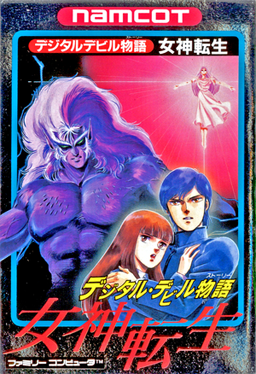 |
Digital Devil Story: Megami Tensei [lower-alpha 1] refers to two distinct role-playing video games based on a trilogy of science fantasy novels by Japanese author Aya Nishitani. One version was developed by Atlus and published by Namco in 1987 for the Famicom—Atlus would go on to create further games in the Megami Tensei franchise. A separate version for personal computers was co-developed by Atlus and Telenet Japan and published by Telenet Japan during the same year. An enhanced port for the Super Famicom by Opera House was released in 1995.
The story sees Japanese high school students Akemi Nakajima and Yumiko Shirasagi combat the forces of Lucifer, unleashed by a demon summoning program created by Nakajima. The gameplay features first-person dungeon crawling and turn-based battles or negotiation with demons in the Famicom version, and a journey through a hostile labyrinth as Nakajima featuring real-time combat in the Telenet version.
Development on both versions of the video game began following the release of an original video animation adaptation of Nishitani’s first Digital Devil Story book in early 1987. Nishitani was deeply involved with the design and scenario. The gameplay mechanics in Atlus’ role-playing version of the game were based on the Wizardry series, but with an added demon negotiation system considered revolutionary for the time. Atlus and Telenet Japan worked on their projects simultaneously, playing against genre expectations for their respective platforms. The Famicom version proved the more popular with both critics and players, leading to the development of the 1990 sequel Digital Devil Story: Megami Tensei II.
Contents
Gameplay [ ]
The player explores dungeons in a first-person view, and battles demons.
The Famicom version of Digital Devil Story: Megami Tensei is a traditional role-playing video game in which the player takes control of a party composed of two humans and a number of demons. The party explores a large dungeon using a first-person perspective. The human characters use a variety of weapons and items, with the primary weapons being swords and guns. The items, which can range from healing items to different types of currency, are picked up from enemies or found in chests scattered through the dungeon. Weapons and accessories are purchased at different shops found within the dungeon. [1] [2] Progress is saved using a password system. [2]
Battles are turn-based, with random encounters taking place while exploring dungeons. At the end of a successful battle, experience points, money, and items are obtained. Experience points are shared by Nakajima and Yumiko; by gaining enough experience points, their levels raise, and they are given one ability point each, which can be given to one of five character attributes: strength, intelligence, attack, dexterity, and luck. During battles, the player can try to persuade enemy demons to join them, in exchange for magnetite, money, or items. The player can keep seven demons at a time, of which up to four can be summoned at the same time; summoned demons aid the player in battles with physical and magic attacks, but cost money to summon, and consume magnetite as the player walks around. The demons’ attitude towards the player is governed by the moon phase, which cycles through eight phases from new to full. Demons do not level up; instead, the player can create stronger demons by visiting a special location and fusing two of their allied demons together into a new one. [1] [2]
The version for personal computers (PC) is an action role-playing game which plays from a top-down perspective. Controlling Nakajima, the player explores the labyrinthine levels of a dungeon populated by enemies. Combat plays out in real time, with Nakajima fighting demons using both short-range melee attacks and ranged magic attacks. Each section of the dungeon ends in a powerful boss character. [2] [3]
Synopsis [ ]
The plot sees Akemi Nakajima, a clever and bullied high school student who is the reincarnation of the deity Izanagi, develop a computer program which summons demons from the realm of demons. Initially using his program to gain revenge on his tormentors, the program goes out of control and he unleashes a horde of demons. The demons are commanded by Lucifer, who resurrects the demonic gods Loki and Set following their defeat by Nakajima and Yumiko. With help from his friend Yumiko Shirasagi, a transfer student that became interested in Nakajima and is the reincarnation of the goddess Izanami, Nakajima takes her into the demon world to help combat the demons. The pair travel into a vast subterranean labyrinth, where they defeat Lucifer’s generals—the Minotaur, Loki, Medusa, Hecate, and Set—before fighting Lucifer himself and defeating him, closing the entrance to the demon world.
Development [ ]
Digital Devil Story: Megami Tensei began as a trilogy of science fantasy books written by Japanese author Aya Nishitani. Published by Tokuma Shoten, the novels were a major success in Japan. The novels were first adapted into an original video animation (OVA), which retold the events of the first novel. [4] [5] Following the completion of the OVA in 1987, Tokuma Shoten decided to expand the series into video games. [5] The license to develop a game based on Nishitani’s work was simultaneously acquired by two companies; Atlus (through Namco [6] ) and Telenet Japan. The two companies were willing to work on the same project, but wanted to differentiate their products. As the Famicom was noted for action-based titles and PCs for traditional role-playing games, the two companies decided to respectively play against platform expectations. [7] Two different game projects were created with Tokuma Shoten’s supervision under the Digital Devil Story: Megami Tensei title; Atlus created a traditional role-playing game which was published by Namco, while Atlus and Telenet collaborated on an action role-playing game which would be published by Telenet. [5] [8] [9] The two versions were developed concurrently, although the version by Telenet was the first to be completed. [5]
The Atlus version was directed by Kouji Okada, [8] while the scenario’s original elements were written by Kazunari Suzuki. [10] [11] Sprite and promotional artwork was designed by Esaki Minoru, [12] and the music was composed by Tsukasa Masuko. [13] During the early phases, the gameplay concept was a near-copy of the gameplay style of the Wizardry series, attributed by Suzuki to their superiors being fans of the series. Suzuki insisted on the inclusion of some new feature which would distinguish it from Wizardry. This resulted in the creation of the demon negotiation system. [14] Okada later stated that demon negotiation was decided upon from an early stage. Speaking later about the first-person exploration, Okada was highly critical, feeling that after all their efforts «All we had left after everything was said and done were lots and lots of long, winding dungeons!». [8] Storage space on the cartridge was a recurring concern for the team, with Suzuki using unspecified programming tricks to include high-quality sprite graphics. [14] Due to the rules of the gaming industry at the time, the teams and studios either went uncredited or had pseudonyms, with Masuko being credited as «Project Satan». [13]
The storyline of the game was based on the final novel in Nishitani’s trilogy, Tensei no Shuuen, [lower-alpha 2] although taking its title from the first novel, Megami Tensei. [lower-alpha 3] [8] [15] Nishitani was deeply involved in planning the game, contributing suggestions and advice for the project. [16] According to Okada, a major issue during development was faithfully following the novel’s plot due to the limited hardware space on the Famicom cartridge, together with the necessity of creating a compelling gameplay experience. With this in mind, the team picked out key parts the novel’s plot to include in the game while cutting out non-essential elements. One element that was not included was the questionable morality of the main protagonist, which was a prominent feature in the novels. [8] Suzuki later commented that it was only because they were working with Namco that the game was ever released, due to its mature character designs and heavy use of religion in the narrative. The Cerberus demon, which would become a recurring feature in later Megami Tensei games, was a homage to the narrative of Nishitani’s trilogy, at the same time emulating the trend for games to have a marketable mascot or character. [14]
Release [ ]
The PC version of the game was published by Telenet Japan for PC88, MSX, X1 and FM-7 models between July and September 1987. [9] The PC88 version was re-released on April 25, 2006 by Kadokawa Shoten as part of a collection of fifteen games for the platform. [17]
The Famicom version of Digital Devil Story: Megami Tensei was published by Namco on September 11, 1987. [18] This version was later re-released through Atlus’s dedicated mobile store; first for NTT DoCoMo mobile devices on February 26, 2004, [19] then through the Vodafone live! service on December 1 of that year, [20] and finally for BREW services on September 29, 2005. [21] The mobile versions, while direct ports, featured graphical improvements, automatic mapping of dungeons and the ability to save anywhere in the game. [22] The Famicom version is planned to be re-released as part of Namcot Collection volume 3 in October 2020 in Japan. [23]
The game received an enhanced port for the Super Famicom by Japanese developer Opera House, combining the game with its sequel. [24] [25] For this version, the graphics were reworked, the gameplay adjusted, and the demon artwork redrawn by then-established series illustrator Kazuma Kaneko. [25] The music was arranged by Hitoshi Sakimoto. [26] Titled Kyuuyaku Megami Tensei, [lower-alpha 4] the port was released on March 31, 1995. [27] This version was re-released on the Virtual Console for Wii on July 3, 2012. [28]
No version of the game has been released outside Japan. [29] This has been attributed to Nintendo’s policy of censoring religious references in games, which rendered the early Megami Tensei titles unsuitable for localization due to their central religious elements. [30] [31] A fan translation of Kyuuyaku Megami Tensei was released on August 28, 2014. [32]
Reception [ ]
In its review, Famitsu compared the 3D dungeon exploration of the Atlus version to the Deep Dungeon series, with the critics giving praise to its gameplay and unusual setting. [18] In an article about the game in 1991, Family Computer Magazine called it a «revolutionary RPG», praising its gameplay and atmosphere despite the design making it easy for players to get lost. [33] Ohta Publishing magazine Continue cited its dark atmosphere and mechanics as both impressive given the limited hardware and innovative among role-playing games of the time. [34] Kurt Kalata and Christopher J. Snelgrove of Hardcore Gaming 101 stated that it was «surprising how in depth the monster catching and fusing elements are given the game’s age», praising its mechanics despite the age and high difficulty curve. In contrast to their praise for the Famicom version, they referred to Telenet Japan’s version as a poor clone of Gauntlet with low-quality graphics. [2] While no specific sales figures are available, Okada said that the game was a commercial success, allowing Atlus breathing room to consider where to next take the series. [8]
The mixture of demon negotiation and recruitment with the traditional role-playing mechanics were considered revolutionary for the time. [35] [36] UGO Networks writer K. Thor Jensen cited the game as the first successful use of cyberpunk aesthetics in video games, saying that the series’ mix of science fiction elements and the occult «create a truly unique fictional cyberpunk world». [37] In a 2012 feature on influential games, Game Informer ‘ s Kimberley Wallace attributed Digital Devil Story: Megami Tensei with pioneering the monster collecting gameplay popularized by the Pokémon series. [38] In a 2015 retrospective on the game’s 1992 successor Shin Megami Tensei, Touch Arcade’s Shaun Musgrave noted the unusual game mechanics within its standardised role-playing formula, and its science fiction-inspired setting in contrast to the fantasy settings dominating the genre at the time. [39]
Legacy [ ]
Following the success of the game, Atlus decided to create a sequel, but instead of continuing to adapt Nishitani’s work, they created an original story with an expanded narrative and refined gameplay. [8] Titled Digital Devil Story: Megami Tensei II, the game was released for the Famicom in 1990. [29] Digital Devil Story: Megami Tensei was the first game in the Megami Tensei series, with Atlus eventually buying the rights to the franchise and turning the series into their most famous intellectual property. [39] Megami Tensei has been called the third most popular RPG series in Japan after Dragon Quest and Final Fantasy, and gone on to include multiple subseries and expansions into other media. [2] [29] [40]
Digital Devil Story: Megami Tensei
Developer: Atlus
Publisher: Namco
Platform: NES
Released in JP: September 11, 1987
Based on a series of Japanese horror novels, Megami Tensei kicked off the long-running RPG series of the same name. When a boy-genius computer hacker figures out a way to summon demons from folklore and religion via the power of COMPUTERS, things go utterly pear-shaped and he has to team up with a friend from school to stop demons from taking over the world! Naturally, this is done by chatting them up and convincing them to fight on his side.
Easter Egg
One particularly strange random monster encounter in the game is a BULL monster, flipped upside-down, with the word «BUG» crudely typed over the sprite. Surprisingly, this is actually deliberately included, as there’s an easter egg tied to it!
When you encounter this enemy in battle, press and hold A + B + Left + Down on the second controller, then select «AUTO» to start the automatic battle mode. The generic message about your character fighting the monster («ナカジマたちはたたかっている。», or «Nakajima and the others start fighting.»), will change to the secret message: «カブちゃんはDEBUGをはじめた。», which translates to «Cabu-chan begins debugging.».
Digital Devil Story: Megami Tensei II
From Wikipedia, the free encyclopedia
Digital Devil Story: Megami Tensei II [a] is a role-playing video game developed by Atlus and published by Namco for the Famicom. An enhanced Super Famicom port was developed by Opera House and released by Atlus in 1995. The second entry in the Megami Tensei series, the gameplay features the unnamed protagonist exploring a post-apocalyptic wasteland, battling and recruiting demons as they are pushed into taking part in a conflict between the demonic forces of Lucifer and the army of the One True God.
Development began in 1987 following the release of Digital Devil Story: Megami Tensei. While the first game was an adaptation of a novel trilogy, Megami Tensei II has an original story that examines preconceptions surrounding the portrayal of order and chaos. Kouji Okada and Tsukasa Masuko returned as director and composer, while artwork was designed by Kazuma Kaneko. The game received critical acclaim upon release, was partially remade in the 1992 Super Famicom title Shin Megami Tensei, and is regarded as an influential entry in the series.
Devil Children (Series)
The Devil Children series is the only series in the franchise whose target audience is children, and as such has a more cartoonish and light-hearted aesthetic despite retaining many of the recurring themes. For the most part, recurring demons appearing in Devil Children do not share their visual design with the other series in the franchise, and were instead given redesigns to better fit with the series’ aesthetic.
The protagonists are the titular Devil Children, half-human and half-demon. Leaning more into a «monster collecting» angle, the games are generally released in pairs and contain version exclusives in order to encourage trading. Story-wise, each game in a pair has its own protagonist. Both protagonists exist in the story at the same time, and each game will tell one singular story from the perspective of its protagonist.
The first entries of the franchise were the Devil Children Black Book and Red Book games and the DeviChil anime adaptation, which were produced concurrently. As of date, the only games released outside of Japan are DemiKids Light Version and Dark Version for the Game Boy Advance.
Contents
Entries [ ]
Games [ ]
Anime [ ]
Manga [ ]
Card Game [ ]
Other [ ]
Gameplay [ ]
Leveling up [ ]
The protagonist does not participate in battle, but they still have a level. As demons do not level up from experience gained in battle, all experience gained is instead given to the protagonist. The protagonist’s level determines how strong of a demon they can fuse or recruit, as those demons can only be at most five levels above the protagonist.
Partner [ ]
All protagonists have a demon partner that stays by their side and cannot be removed from the party. It’s possible for the protagonist to ride their partner in demon-infested areas for a faster moving speed at the cost of an increased encounter rate. While riding the partner, the protagonist can overcome obstacles such as jumping over ledges or digging tunnels underground, which may be either necessary to progress in certain areas, be used to access shortcuts, or be used to reach hidden areas.
All demons have an experience value assigned to them. Fusing any demon with the partner will make the partner absorb that experience, which allows them to level up. Furthermore, even if the partner hasn’t accumulated enough experience to level up, fusing them with any demon may increase its stats. This increase is based on the level difference between the partner and the second demon: in most cases one random stat will be increased by 1, but multiple points will be assigned to random stats if the second demon’s level far exceeds the partner’s, and no increase will happen if the second demon is of a much lower level than the partner. This system is highly abusable as one can easily fuse the partner with weak demons to drag out levels and accumulate stat bonuses.
At certain points in the story, the partner will evolve into a stronger form. Each new form has its own base level and stats, but the partner’s level and stats won’t be overwritten unless they’re lower than the new form’s.
Number of Skills [ ]
All demons have six natural skills, but for the most part only the first three are available. The way of unlocking the final three skills (which tend to be stronger) varies depending on the game and its fusion mechanics. Depending on the game, it may be impossible to unlock all natural skills.
Partners start with their first three skills, and learn the remaining ones via level up.
Fusion [ ]
Except for White Book, each game in the series is released in pairs and has a different fusion system than its counterpart.
Black Book, Light Version, and Fire Book have a system similar to most games of the Megami Tensei franchise, in which the player fuses two demons of different races together to create a stronger demon. Demons created via fusion will gain access to their fourth natural skill, but the remainder two are not available.
Red Book, Dark Version, and Ice Book have a unique fusion system. When fusing two demons:
When strengthening demons via this method, their base level won’t change. However, the demons will still accumulate experience and «level up,» though this level is not displayed to the player. This is done to prevent overt abuse of this strengthening method, tying it to the rule that dictates the player cannot have a demon over five levels stronger than the protagonist. Nevertheless, this system is still just as abusable as strengthening your partner.
White Book is the only game where both fusion method are available, but not at the same time. Most towns will only offer one type of fusion, while only a select few offer both methods.
Digital Devil Story: Megami Tensei
16-мегабитный картридж для Super Famicom
Digital Devil Story: Megami Tensei (яп. デジタル・デビル物語 女神転生 Dejitaru Debiru Monogatari Megamitenshō) — видеоигра в жанре RPG, основанная на трилогии научно-фантастических романов японского автора Ая Ниситани. Первая версия игры была разработана Atlus и выпущена Namco в 1987 году для Famicom. Версия для персональных компьютеров была разработана совместными усилиями Atlus и Telenet Japan и выпущена Telenet Japan в том же году. Улучшенный порт для Super Famicom от Opera House был выпущен в 1995 году.
История повествует о японских старшеклассниках Акэми Накадзима и Юмико Сирасаги, сражающихся с силами Люцифера высвобожденными программой призыва демонов, созданной Накадзимой. Игровой процесс включает в себя изучение подземелий от первого лица, пошаговые сражения и диалоги с демонами, а также путешествие по враждебному лабиринту Накадзима в версии для Famicom, сражения в котором происходят в реальном времени в версии для PC.
Разработка обеих версий игры началась после выпуска оригинальной анимационной адаптации первой книги Ниситани Digital Devil Story в начале 1987 года. Ниситани был глубоко вовлечен в дизайн и сценарий. Механика игрового процесса была основана на серии игр Wizardry, но с добавленной системой диалогов с демонами, считавшейся революционной для того времени. Atlus и Telenet Japan работали над своими проектами одновременно, играя против жанровых стереотипов своих платформ. Версия для Famicom оказалась более популярной среди критиков и геймеров, породив продолжение под названием Digital Devil Story: Megami Tensei II в 1990 году.
Содержание
Игровой процесс
Сражения пошаговые, со случайными встречами, происходящими во время изучения подземелий. В конце успешной битвы вы получаете очки опыта, деньги и предметы. Очки опыта делят между собой Накадзима и Юмико, набрав достаточное количество очков опыта, их уровни повышаются, и им даётся по одному очку способности, которые могут быть даны одному из пяти атрибутов персонажа: сила, интеллект, атака, ловкость и удача. Во время сражений игрок может попытаться убедить вражеских демонов присоединиться к нему в обмен на магнетит, деньги или предметы. Игрок может держать семь демонов одновременно, из которых до четырёх могут быть вызваны одновременно; вызванные демоны помогают игроку в битвах с физическими и магическими атаками, но вызов стоит денег, и потребляют магнетит, когда игрок ходит. Отношение демонов к игроку определяется фазой луны, которая проходит через восемь фаз от новой до полной. Демоны не повышают свой уровень, вместо этого игрок может создать более сильных демонов, посетив специальное место и объединив двух своих союзных демонов в одного нового.
Сюжет
По сюжету Акеми Накадзима — ученик старшей школы, являющийся реинкарнацией божества Идзанаги, разрабатывает компьютерную программу, которая вызывает демонов из Макая — мира демонов. Первоначально он хотел использовать свою программу, чтобы отомстить своим обидчикам, но она вышла из-под контроля и выпустила полчища демонов. Демонами командует Люцифер, который воскрешает демонических богов Локи и Сета после их поражения Накадзимой и Юмико. С помощью своего друга Юмико Сирасаги — студентки-переводчицы, являющейся реинкарнацией богини Идзанами, которая увлечена Накадзимой, он борется с демонами в Макае. Пара путешествует по огромному подземному лабиринту, где они побеждают генералов Люцифера, включая Локи и Сета, прежде чем сразиться с самим Люцифером и победить его, закрыв вход в Макай.
Разработка
Релиз
Оценки
Devil Survivor
Devil Survivor
女神異聞録デビルサバイバー
Megami Ibunroku Debiru Sabaibā
Game Information
Developer
Publisher
Genre
Platform
Release Dates
Japan 
North America 
An enhanced port was released for the 3DS on August 23, 2011, titled Devil Survivor Overclocked. A novelization was released in two parts as the Devil Survivor Novel Anthology.
Its character designs are handled by Suzuhito Yasuda of Durarara and Yozakura Quartet fame. The theme song for the game is «Reset.»
Contents
Day Before An End to the Ordinary [ ]
Devil Survivor is set in modern-day Tokyo. One day, the protagonist, a 17 year-old student, finds that he and his two friends, Atsuro Kihara, a computer hacker, and Yuzu Tanikawa, a spirited fighter, have been given modified electronic devices called COMPs by his older cousin Naoya. Atsuro finds that the menu for the COMPs are different from his own back home. After a thorough investigation of the COMPs received from Naoya, Atsuro accidentally activates a program that summons demons. After fending off the demons released from the COMPs, the protagonist, Yuzu, and Atsuro debate on keeping the COMPs. Though Yuzu put up a reasonable argument, they remember Naoya saying they would need them, so they decide to go look for him to get some questions answered. However Naoya tells them to go to Minato-ku Aoyama cemetery, for he said they would meet a person who would influence their future actions.
1st Day: Tokyo Lockdown [ ]
As they are exploring their purpose, an outbreak of demons occurs within Tokyo, and a large city area is quarantined by the Japanese Ground Self-Defense Forces, deny power, communications, and food to those trapped within it; the chaotic situation created vigilantes of those trapped who try to take it on themselves to fight the demons or even on weaker humans. The protagonist and his friends discover their COMPs allow them to summon helpful demons to fight the aggressive ones, allowing them to survive the attacks. The protagonist also finds he has the ability to see a person’s «death clock», representing how many days a person will have left to live. While he uses it to help himself and his friends to change their own fate, the protagonist realizes that everyone within the quarantine will die within seven days.
2nd Day: Any Way Out [ ]
As they try to learn the mystery of the lockdown, they encounter several playable character allies: Keisuke Takagi, Atsuro’s school friend who has a strong sense of justice; Midori Komaki, a cosplay idol, personifying her role in protecting the innocent from demons; Eiji Kamiya, or «Gin», the manager of a local live music bar; Tadashi Nikaido, or «Kaido», the charismatic leader of the street gang, the «Shibuya Daemons»; Mari Mochizuki, an elementary school tutor seeking the demon that killed her lover; Misaki Izuna, a military officer overseeing the quarantine; Amane Kuzuryu, the daughter of the leader of the Shomonkai, a religious cult that seems to be behind the demon outbreak; and Black Frost, a demon that helps other weaker demons from ruthless human attacks after being saved by Midori. Other allies include: Yoshino Harusawa, or Haru, a singer who believes her song was responsible for the demon outbreak; Yasuyuki Honda, a company man trapped in the quarantine while his son, outside it, is undergoing a serious operation; and Shoji, a female journalist that had been investigating the events leading to the quarantine before it started.
3rd Day: Beldr [ ]
The Japanese government had been aware of this event for years, and had enacted the PSE Law as a safeguard, which embedded remote-controlled electromagnetic devices in every consumer electronics; if the demon outbreak cannot be not stopped, the government can use these devices at the last moment to destroy all living things within the quarantine, human and demon alike.
4th Day: Crumbling Reason [ ]
5th Day: Revelations [ ]
Through their investigation, the protagonist and his allies find that the demon outbreak is a result of a planned battle between angels and demons, as a measure to judge the worthiness of mankind. If, after seven days, the demons are not stopped, the angels will destroy mankind. As the plot goes on, the protagonist unintentionally involves himself in the battle for the Throne of Bel, making him a target for all other demons that are in competition with him.
6th Day: The Decisive Moment [ ]
Depending on the path players take, the protagonist comes to learn that Naoya and himself are the reincarnations of the biblical Cain and Abel, respectively. Naoya worked with the Shomonkai to create the programs to summon demons to bring about this event, initially through the keyboard used by Aya, one of Haru’s band members. The Shomonkai sought to bring the king of demons Belberith to the world in order for the demons to win the battle, and Naoya required the protagonist and his friends to survive long enough for this event to happen.
Numerous choices made by the player will affect his friends and allies, and there are several endings to the game, which include whether the player’s goal is to simply escape the quarantine or to prevent the demon uprising. The latter can be accomplished several ways, including controlling demons as the Messiah, controlling demons as the Lord of Bel, controlling demons for humanity’s sake, or erasing demons from Earth altogether.
Excluding «Desperate Escape», all endings will require the player to defeat the remaining three of the Four Devas, and Jezebel (Who is also excluded in «Silent Revolution»), as well as the demons Beelzebub, Belberith, and Babel.
Desperate Escape [ ]
The Desperate Escape ending is triggered when the player chooses to talk to Yuzu at the end of the sixth day, or if the player fails to save Haru. The player will have to defeat Gigolo, who is revealed to be the demon Loki, and finally defeat the angels who are led by Amane and Izuna. The escape succeeds, but Honda’s son dies and Honda reveals that all COMP users now have free reign over the world, creating a world of chaos where the strong rule. In the Overclocked remake, the escape caused the protagonist, Yuzu, and Atsuro to be branded as fugitives, and their families are taken into custody by the SDF, leading the three to return to the lockdown.
Returning to the lockdown, the government decides to cut ties with the angels and then Metatron declares that God has forsaken humanity, leaving them to handle the demon outbreak by themselves. To clear their names, the protagonist and the party negotiate with the SDF to release their families by killing Belzaboul and Belberith and capture the Shomonkai founder. The ending depends whether you complete the side quest of restoring the barrier with the four Devas or not. If the barrier is restored, the demons are barred from entering Tokyo and the party works with the government to get rid of all of the remaining demons. If the barrier is not restored, humanity is locked in eternal war against demons.
King of Demons [ ]
King of Demons ending is triggered when you choose to talk to Naoya at the end of the sixth day. Choosing this path will cause Yuzu, Midori, and Keisuke to leave your party, but you will be joined by Naoya and Kaido. You receive word that the deadline for the government’s final option has been moved up to noon; Naoya negotiates with Fushimi and successfully convinces him to move the deadline back two hours. You have to defeat Jezebel, one of Belberith’s servants and is residing in Amane, by connecting a COMP to Amane’s mind. After subduing the Remiel and the Shomonkai members guarding Amane and defeating Jezebel, the party proceeds to the Hills building, where they are confronted by Anael, Sariel, and Beelzebub. Following these battles, the party ascends the building and faces Belberith and Babel.
The protagonist gains the power of the King of Bel, and all over the city people are left fearing for the future as he rallies the demons to prepare for a war with God. In the Overclocked, during the eighth day, Metatron orders for everyone in the lockdown to kill the protagonist with a promise they will lift the lockdown once the King of Bel is killed. Naoya gives you two options: kill only the angels and convince people in the lockdown that the angels are the true enemies, or kill anyone who gets in their way.
Kingdom of Saints [ ]
Kingdom of Saints ending is triggered when you choose Amane’s route at the end of the sixth day. After you’ve defeated the Four Devas and Belberith you summon Babel. After you’ve defeated it you become the King of Bel then the Messiah. In the Overclocked remake, during the eighth day you fight Honda who is crazed because his son died. His anger summons Susanoo the guardian deity of Japan.
After you’ve defeated Honda, Okuninushi, the creator of Japan, appears and challenges the protagonist to convince the first murderer in history, Cain, who is now reincarnated as Naoya to forgive God or he will destroy the country and rebuild it anew. In the end, the protagonist and Naoya team up to defeat Okuninushi. After that the lockdown is lifted and the protagonist will continue his duty as the Messiah, judging people for their sins and having them live pure lives out of the devotion of God. When this path is over you can fuse Metatron in the Cathedral of Shadows.
Silent Revolution [ ]
Silent Revolution ending is triggered when you talk to Atsuro at the end of the sixth day. You must defeat Naoya who will agree to change the server. You will not fight Jezebel in this route because Amane will explain that Jezebel has suddenly disappeared (implying that she either ran away, or was killed by Belberith). You will then fight Belberith and summon Babel. Defeating Babel will allow you to command it to operate based on the new server, which will allow only selected forces, such as the military, police, or government, to control the demons.
Song of Hope [ ]
Song of Hope ending is triggered when you talk to Gin at the end of the sixth day. After defeating the Four Devas and Belberith, you must protect Haru and control Atsuro so that both will reach the server and summon Babel. Defeating Babel’s first form will send the demons back into the demon world, making them unusable when battling Babel’s second form. If the player has succeeded in recruiting Black Frost in this ending, then Black Frost will disappear as well. The demons and angels both leave, the incident is covered up as hallucinations caused by gas leaks, and the COMPs stop working.
Early Bad Ending [ ]
Also known as the Honda false ending, this is one of six possible endings. However, it is not a true ending, more akin to a nonstandard game over — it does not allow access to New Game + mode and at the end the game acts as if the player failed a required objective.
On this route, the protagonist discovers Honda and three other civilians approaching a seemingly undefended segment of the lockdown wall, having just observed a demon slay the last SDF member guarding the wall. Upon approaching the empty space, angels appear, killing two of the civilians outright and threatening the others.
Upon seeing this, the player has three options — support the demons, support the angels, or support humanity. Picking the earlier two requires the player to attack the other side, then defeat and destroy the civilian’s COMPs to prevent them from getting themselves killed. Picking the third allows the player to attack both the angels and the demons at the same time, though this strangely does not affect whether the player has a better chance at getting Naoya’s or Amane’s ending.
Midway through the battle, Honda and the civilian decide to take this opportunity to escape, and the player can choose to do so as well. However, immediately upon exiting the area, a strange lightning storm appears over the lockdown — the Angels have declared the lockdown a failure, and have decided to kill everyone inside. Worse still, they have declared humanity to be in default of their responsibilities as children of God, and an Angelic army flies out to enslave the world. Anyone not sufficiently subservient is killed outright, and the remainder are stripped of their free will.
The game then acts as if the player lost a battle — «Mission Failed» — and sends the player back to the load game screen.
If neither the player nor the civilians escape, the ending is averted. When this happens, SDF soldiers appear to defend the wall, and the protagonist’s party (along with any surviving civilian on the scene) promptly leaves before they are attacked.
Characters [ ]
Gameplay [ ]
Devil Survivor can be described as one part visual novel, one part tactical RPG. Most of the story takes place by the player selecting events from a map, with an in-game clock dictating how much «time» is left to make decisions. Naturally, most of the plot-critical or character-focused events consume time, with 30 in-game minutes consumed per event. The player’s choices throughout the game will influence when certain events can be accessed, and for how long, ultimately influencing the outcome of the plot.
Battles [ ]
Battles occur on a grid-based map. However, the player must first dispatch up to 4 teams of (up to) three, each containing one leader and up to two demons. Prior to dispatching, the player has the opportunity to view the enemies on the field (and their skills and elemental affinities) and customize teams to best combat them.
Teams consist of the team leader positioned in the center, and members flanking the leader. The leader takes less damage than the members, but if the team leader is defeated, combat ends immediately and the leader’s team is removed from the map. However, this also halves EXP and Macca earned from team members that are still alive. Likewise, reviving the team leader will replace the team on the battlefield, along with any members that were still alive.
Demon Fusion [ ]
Fusing of demons is significantly different compared to other Shin Megami Tensei games as well. Each demon can only learn up to three Command and three Passive Skills, rather than up to eight different skills in other games. In exchange for reduced flexibility, the player is able to control the skills passed on to demons during fusion. However, inherited skills can only be placed in empty skill slots, as preset or learnt skills cannot be overwritten. Certain demons are also Unique, which means that the player can only have one copy of said demon at any one time, and would need to fuse it off if another one were to be made.
Macca Bonus [ ]
After the system is introduced, the player can receive bonuses or penalties to earn Macca depending on how well they performed in battle. Stealing Extra Turns and defeating multiple enemies in a single move, for example, increases earned Macca, while hitting enemy immunities and taking casualties in combat decreases it.
Routes [ ]
Routes are, for the most part, only found in the Devil Survivor games. While other Megami Tensei games do have various endings, Devil Survivor is the only series to refer to their endings as routes. Routes are various paths that you can choose to take at the climax of the games. Certain routes will be open or closed depending on the actions that you make throughout the game. Unlike most other Megami Tensei games, the routes you can take do not depend on your alignment, but instead depend on whether the route will be possible within the context of what has happened and whether the route’s character likes you or not.
Reception [ ]
Devil Survivor has received mostly positive reviews praising its unique gameplay, intriguing story with suspense and meaningful decisions and high variety of character customization.
Digital Devil Story: Megami Tensei
16-мегабитный картридж для Super Famicom
Digital Devil Story: Megami Tensei (яп. デジタル・デビル物語 女神転生 Dejitaru Debiru Monogatari Megamitenshō) — видеоигра в жанре RPG, основанная на трилогии научно-фантастических романов японского автора Ая Ниситани. Первая версия игры была разработана Atlus и выпущена Namco в 1987 году для Famicom. Версия для персональных компьютеров была разработана совместными усилиями Atlus и Telenet Japan и выпущена Telenet Japan в том же году. Улучшенный порт для Super Famicom от Opera House был выпущен в 1995 году.
История повествует о японских старшеклассниках Акэми Накадзима и Юмико Сирасаги, сражающихся с силами Люцифера высвобожденными программой призыва демонов, созданной Накадзимой. Игровой процесс включает в себя изучение подземелий от первого лица, пошаговые сражения и диалоги с демонами, а также путешествие по враждебному лабиринту Накадзима в версии для Famicom, сражения в котором происходят в реальном времени в версии для PC.
Разработка обеих версий игры началась после выпуска оригинальной анимационной адаптации первой книги Ниситани Digital Devil Story в начале 1987 года. Ниситани был глубоко вовлечен в дизайн и сценарий. Механика игрового процесса была основана на серии игр Wizardry, но с добавленной системой диалогов с демонами, считавшейся революционной для того времени. Atlus и Telenet Japan работали над своими проектами одновременно, играя против жанровых стереотипов своих платформ. Версия для Famicom оказалась более популярной среди критиков и геймеров, породив продолжение под названием Digital Devil Story: Megami Tensei II в 1990 году.
Содержание
Игровой процесс [ | ]
Сражения пошаговые, со случайными встречами, происходящими во время изучения подземелий. В конце успешной битвы вы получаете очки опыта, деньги и предметы. Очки опыта делят между собой Накадзима и Юмико, набрав достаточное количество очков опыта, их уровни повышаются, и им даётся по одному очку способности, которые могут быть даны одному из пяти атрибутов персонажа: сила, интеллект, атака, ловкость и удача. Во время сражений игрок может попытаться убедить вражеских демонов присоединиться к нему в обмен на магнетит, деньги или предметы. Игрок может держать семь демонов одновременно, из которых до четырёх могут быть вызваны одновременно; вызванные демоны помогают игроку в битвах с физическими и магическими атаками, но вызов стоит денег, и потребляют магнетит, когда игрок ходит. Отношение демонов к игроку определяется фазой луны, которая проходит через восемь фаз от новой до полной. Демоны не повышают свой уровень, вместо этого игрок может создать более сильных демонов, посетив специальное место и объединив двух своих союзных демонов в одного нового.
Сюжет [ | ]
По сюжету Акеми Накадзима — ученик старшей школы, являющийся реинкарнацией божества Идзанаги, разрабатывает компьютерную программу, которая вызывает демонов из Макая — мира демонов. Первоначально он хотел использовать свою программу, чтобы отомстить своим обидчикам, но она вышла из-под контроля и выпустила полчища демонов. Демонами командует Люцифер, который воскрешает демонических богов Локи и Сета после их поражения Накадзимой и Юмико. С помощью своего друга Юмико Сирасаги — студентки-переводчицы, являющейся реинкарнацией богини Идзанами, которая увлечена Накадзимой, он борется с демонами в Макае. Пара путешествует по огромному подземному лабиринту, где они побеждают генералов Люцифера, включая Локи и Сета, прежде чем сразиться с самим Люцифером и победить его, закрыв вход в Макай.
Разработка [ | ]
Релиз [ | ]
Оценки [ | ]
Digital devil story megami tensei
Game Description:
Digital Devil Monogatari: Megami Tensei is an role playing game for the Nintendo Entertainment System.
Translation Description:
This is a complete translation patching set for Digital Devil Story: Megami Tensei on the Famicom (NES). The translation was done from Japanese into American English.
Please note that not all emulators support the translation due to the ROM expansion.
Quantum Devil Saga: Avatar Tuner
The English cover of the first volume
Quantum Devil Saga: Avatar Tuner (クォンタムデビルサーガ アバタールチューナー) is a five-volume series of novels set in the world of Digital Devil Saga. Authored by Yu Godai, an original story writer of the games who had to leave the project due to health issues, they explore the events of the games differently and diverge from them.
The series originally was published in Japan starting in February 2011. The first volume’s English release, translated by Kevin Frane, was released on July 31st, 2014, by publisher Bento Books. He has confirmed in late 2014 he was working on the second volume; as of September 13th, 2017, the second volume has been released. So far, there is no confirmation of the third volume’s translation.
Contents
Characters [ ]
Six tribes battle in the post-apocalyptic Junkyard, a grim world of demons and evil powers that block entrance to the promised land, Nirvana.
Digital Devil Story: Goddess Reincarnation
(Digital Devil Story #1)
Get A Copy
Friend Reviews
Reader Q&A
Lists with This Book
Community Reviews
I’m new to the Shin Megami Tensei series. While I’ve heard of it, this is actually my introduction to it. I must say, while flawed, I did enjoy this «novella» and am very glad that it was finally translated into English. The book had some serious issues with character development and somewhat of an obsession with bizarre gore, but there were enough original ideas in it to entice me into reading it to completion. While I’m not new to Japanese mythology this book did introduce me to more details a I’m new to the Shin Megami Tensei series. While I’ve heard of it, this is actually my introduction to it. I must say, while flawed, I did enjoy this «novella» and am very glad that it was finally translated into English. The book had some serious issues with character development and somewhat of an obsession with bizarre gore, but there were enough original ideas in it to entice me into reading it to completion. While I’m not new to Japanese mythology this book did introduce me to more details and factoids I was unaware of.
Being a big fan of the game series that was ultimately started off by this light novel, I was thrilled to find a fan translation of it at MeNaSe Publications. And while it certainly was interesting to see the humble origins of such an awesome and deep game franchise, I confess that the book ultimately left me a bit disappointed. Whether it was due to the translation effort or the original novel, I can’t really tell, but there was a lot of “third-party omniscient” explanation and exposition throu Being a big fan of the game series that was ultimately started off by this light novel, I was thrilled to find a fan translation of it at MeNaSe Publications. And while it certainly was interesting to see the humble origins of such an awesome and deep game franchise, I confess that the book ultimately left me a bit disappointed. Whether it was due to the translation effort or the original novel, I can’t really tell, but there was a lot of “third-party omniscient” explanation and exposition throughout that would have made a much better story had even half of that information been things that we get to see the characters figure out on their own. This, I feel, also contributed to just how short the novel was. I read this thing in only a couple of hours. It could have stood some fleshing out.
That being said, it was quite a creative idea that the author played with. A teenage computer programmer back in the 80s sees the similarity between coding and magical theory, and works out a program to summon demons from other worlds. Just enough detail went into the scheme to avoid contradictions without giving too much away, thankfully, so while the idea was a little vague, it will worked. Naturally, though, this teenagers doesn’t quite understand what he’s dealing with, and in getting his revenge on the students who tormented him, he goes somewhat mad with power and starts working with the god Loki, to assist Loki in gaining full physical form and taking over the world. Unfortunately, they didn’t count in the intervention of other deities, one of whom was reincarnated as a recent transfer student to the school.
What struck me in particular is that while Japanese deities were indeed referred to as such, Loki, a deity in his own right, was referred to as a demon through the whole novel. Likewise, when a substance is found that destroys demons, Japanese deities seem immune to it while Loki is vulnerable. Whether that was a show of religious/mythological arrogance or whether it was a simple oversight remains to be seen, as I have not read the rest of the trilogy that contains this book. If the rest of the books remain as deep and significant as the games that were eventually spawned from this novel, then I’m inclined to believe the former theory, as almost nothing in those games is without significance. But I can’t say for certain at this time.
This is where it all began, and with it I mean the third pillar of the Japanese RPG world beside Final Fantasy and Dragon Quest, the Shin Megami Tensei series (though these days the Persona spinoff is more famous). Which started on the SNES and was build on the foundations laid by the Megami Tensei series from NES, itself based on the first book of a trilogy of horror novels by Aya Nishitani. And the book really is the start of it all.
A Japanese high school kid summons a demon after he got bulli This is where it all began, and with it I mean the third pillar of the Japanese RPG world beside Final Fantasy and Dragon Quest, the Shin Megami Tensei series (though these days the Persona spinoff is more famous). Which started on the SNES and was build on the foundations laid by the Megami Tensei series from NES, itself based on the first book of a trilogy of horror novels by Aya Nishitani. And the book really is the start of it all.
A Japanese high school kid summons a demon after he got bullied in school, loses control over it after some time, and then together with another high school kid fights back, while both have discovered they are the reincarnations of powerful Japanese gods. Despite being so essential for the series, this isn’t a good read or a good book in general. What I read was fan-translated in 2006, so one could argue some of the weaknesses of the book could be laid at the feet of the translator, but even then I doubt it’s all on him.
It’s not just that the writing feels rather ham-fisted and amateurish (given the book started on the web on a BBS, like modern web novels, so no big surprise there), the book is also structurally rather weak. Characters are presented one way, then shift their motivation 180 when the plot needs them to be someone else. The teenager who started the whole demon summoning kills a couple of his classmates mercilessly only then to later become the hero in a turn-around that’s rather inauthentic.
And once the whole reincarnation angle got introduced, a major part of the plot after all, it was all a bit too much. At around 100 pages this is rather short, and yet I had to force myself to get through it and the only reason I did was because it’s the origin of the whole SMT series, not because I thought it was valuable in and of itself. It’s a beginner’s novel, and not by somebody particularly gifted but somebody barely able to string a couple sentences together. The pacing is all over the place, the horrific effects (lots of slaughter and gore and skull-crushing) come off as unintentionally comedic and the characterization is utterly inept to the point I did not only not care about the characters but didn’t feel like they were real characters to begin with. This is just bad on all fronts.
It is kinda impressive how this got enough traction to get professionally published and even games made based on it. I’m thankful for that, as the SMT series is great, but I would have expected the source material to be somewhat better than this.
Este livro foi o que deu origem à série MegaTen da ATLUS. Peguei para ler porque sou fanboy de MegaTen e achei que teria que ter uma introdução «formal» às raízes do treco. Hã. como posso dizer. o livro é bem simples. Eu esperava um épico como Teito Monogatari, mas na verdade o enredo é bem básico: Nakajima (o protagonista) apanha no colégio, desenvolve um programa para invocar demônios, mata algumas pessoas, a aluna transferida Yumiko se envolve com isso sem querer, e aí tudo já é 3/4 do en Este livro foi o que deu origem à série MegaTen da ATLUS. Peguei para ler porque sou fanboy de MegaTen e achei que teria que ter uma introdução «formal» às raízes do treco. Hã. como posso dizer. o livro é bem simples. Eu esperava um épico como Teito Monogatari, mas na verdade o enredo é bem básico: Nakajima (o protagonista) apanha no colégio, desenvolve um programa para invocar demônios, mata algumas pessoas, a aluna transferida Yumiko se envolve com isso sem querer, e aí tudo já é 3/4 do enredo total. Não é muito bom ou imaginativo para os dias de hoje, mas imagino que, na época em que foi lançado (1986) deva ter sido uma revolução na FC/F japonesa, a ponto de criarem jogos a partir da ideia central.
I read a fan-translation of this novella. It has never been officially brought over, which is a little surprising to me, given what an interesting historical curiosity it is—it (and its sequels) was adapted into a video game, “Digital Devil Saga – Megami Tensei,” which spun out into a massive, decades-spanning meta-series including the Shin Megami Tensei series and the Persona series. In terms of influencing pop culture, this is a major work.
As a work of literature, ah … so there’s this cool and I read a fan-translation of this novella. It has never been officially brought over, which is a little surprising to me, given what an interesting historical curiosity it is—it (and its sequels) was adapted into a video game, “Digital Devil Saga – Megami Tensei,” which spun out into a massive, decades-spanning meta-series including the Shin Megami Tensei series and the Persona series. In terms of influencing pop culture, this is a major work.
As a work of literature, ah … so there’s this cool and attractive nerd, Nakajima, who all the girls want to date, but he’s too much of an “independent maverick” for them, so one of them (who the novel helpfully describes as a “dirty, cowardly woman,” in case you weren’t picking up what Aya Nishitani was putting down) has her friend from the karate club beat him up. So he uses a demon-summoning program he’s created to summon Loki to kill them, as one does. Things initially seem to be going his way, but he inevitably loses control, and must team up with another student to try to fix things. For a given value of «team up.» She spends most of the novel being dead, and will spend most of the second novel tied to a cross, naked, so look forward to that.
I’ve been a fan of Megaten series for a long time and finally decided to pick up the first entry I have to say it was not a good novel that is certain, the writing felt more like a fanfiction than a book and some aspects of it were very primitive but I still enjoyed it a lot. I wouldn’t really recommend it to someone that isn’t already a megaten fan but if you are and you want to know what started the series then I think it’s worth reading especially because it’s short and not so engaging.
Now o I’ve been a fan of Megaten series for a long time and finally decided to pick up the first entry I have to say it was not a good novel that is certain, the writing felt more like a fanfiction than a book and some aspects of it were very primitive but I still enjoyed it a lot. I wouldn’t really recommend it to someone that isn’t already a megaten fan but if you are and you want to know what started the series then I think it’s worth reading especially because it’s short and not so engaging.
Now onto more detailed review containing spoilers,
I liked it as a schlocky kinda dumb read. The era this was different sure was different, still sort of holds up in terms of horror.
Some parts are weird though, like the and the two import workers being attacked for some reason.
It’s no mystery that one of my favorite videogame franchises is the venerable “MegaTen” series, which is shorthand for “Shin Megami Tensei” and encompasses a “main series” and its spinoffs. The first entry in the series, Digital Devil Story: Megami Tensei, was released in 1987 on the Famicom (NES) and its success spawned the entire franchise that still has new games coming out yearly. Few people realize, however, that this entire franchise was originally a book by Aya Nishitani. I’ve wanted to r It’s no mystery that one of my favorite videogame franchises is the venerable “MegaTen” series, which is shorthand for “Shin Megami Tensei” and encompasses a “main series” and its spinoffs. The first entry in the series, Digital Devil Story: Megami Tensei, was released in 1987 on the Famicom (NES) and its success spawned the entire franchise that still has new games coming out yearly. Few people realize, however, that this entire franchise was originally a book by Aya Nishitani. I’ve wanted to read the original novella that started the whole thing for quite a while, but the lack of an actual translated book and my desire not to read thousands of words on a computer screen kept me away until now. I did see an old anime OVA based on this book years ago (check youtube for Megami Tensei OVA) but it’s pretty bad despite being largely true to the book. I finally noticed that Goodreads hosts a translation of the book in a ebook format, and I jumped on it.
Akemi Nakajima attends a prestigious school called Jusho High (the gifted class no less) and despite being a genius, is having trouble in his classes. He is distant, ignores his schoolwork, and has few friends. This all seems to stem from the bullying he deals with from day to day. The book opens with Nakajima fighting with a male and female classmate because he ignored her romantic advances and is some kind of lunatic and gets her boyfriend to beat Nakajima up. He is plagued by nightmares of ancient gods Izanagi and Izanami, the gods from the Japanese creation myth, roughly the equivalent to Adam and Eve in Christian culture.
Instead of being a mature adult, Nakajima uses his vast intelligence with computers and new found fascination with the occult to create a demon summoning program for his computer. He plans, with some success eventually, to get a demon to take revenge on his bullies and make him more prominent at school. What he doesn’t know is that he should never trust a demon and has his life thrown into utter chaos. It’s hard to pin Nakajima down as the “hero” of this story as he is basically a giant sociopath for about half the book. It isn’t until the presence of his love interest, a transfer student named Yumiko, that he stops being a total D-bag. I don’t mean benign either – his is directly responsible for rapes, murders, and brainwashing until he flips a total 180 to being a heroic lover this side of Shakespeare’s Romeo.
This weird characterization is one of the real reasons I have given this book an average review – yeah I see all of the building blocks here that eventually became one of my favorite videogames of all time, but the characters seem one-dimensional and switch personalities half-way through the book. Perhaps this is the fault of the translation I have, or characterization was not the purpose of this story. To me, Mr. Nishitani excels at describing horrific gore and body horror, and the majority of his descriptive prose is there to make the reader’s stomach turn.
. more
It reads a lot like an 80’s John Carpenter movie. I’m not really sure how else to put it.
I read this largely because I am a massive MegaTen fan, and had actually not realized that the original inspiration for Megami Tensei came from a light novel. It only took one sitting to finish.
I found some value in it because I enjoy MegaTen, but it’s definitely kind of. bad. Lots of gore, lots of squick, lots of «what the hell?» in this book (to quote from the translation: «The heads of the two men, whos It reads a lot like an 80’s John Carpenter movie. I’m not really sure how else to put it.
I read this largely because I am a massive MegaTen fan, and had actually not realized that the original inspiration for Megami Tensei came from a light novel. It only took one sitting to finish.
I found some value in it because I enjoy MegaTen, but it’s definitely kind of. bad. Lots of gore, lots of squick, lots of «what the hell?» in this book (to quote from the translation: «The heads of the two men, whose features were now distorted far beyond anything normal, limped loosely, and their bodies dissolved into puddles of slime like rotten fruit on the ground.»)
Разговор с демоном: краткая история серии Megami Tensei
Откуда пошла серия игр Persona.
В честь выхода Persona 5 читатель DTF написал текст о серии Megami Tensei, из которой и выросла игра, штурмующая Metacritic. Публикуем с незначительными правками.
Persona 5 ворвалась на вершину Metacritic с оценками, близкими к The Legend of Zelda: Breath of the Wild (одна из самых высокооценённых игр последнего времени, между прочим). Год только начался, а тенденция выпускать отличные игры уже стартовала. Nintendo смогли, Sony тоже, теперь осталось дождаться новой линейки игр от Microsoft и конца споров обладателей разных систем мы не увидим еще очень долго.
Некоторых может смутить цифра «пять» в названии последней части Persona, но переживать не стоит: почти каждая игра серии — отдельная история, где свои герои, трудности, антураж, а порой и мир. Но самое интересное заключается в том, что Persona является спин-оффом еще большей серии — Megami Tensei. О ней и её ответвлениях пойдёт речь.
Стоит сразу отметить, что разбор будет довольно поверхностным и будет полезным для незнакомых с серией вообще, а может — только с Persona. Мне хотелось передать общее настроение развитие сериала, не более.
Новелла была очень популярной, поэтому по ней вышло одноименное аниме и две игры только для внутреннего рынка Японии на MSX и Famicom. Позже вышло ещё несколько игр для системы SNES, но дальше Японии они, опять же, не уходили.
Игры серии Shin Megami Tensei обычно представляют собой dungeon crawler в самом классическом его понимании — блуждаем по подземельям, собираем коллекцию демонов, сражаемся, периодически зарисовываем карту местности в тетрадку, чтобы не заблудиться.
Одна из важнейших систем игры — скрещивание. SMT позволяла взять двух слабых демонов и сделать из них одного, но гораздо более сильного. Случалось так, что в финале игры можно было иметь в своём распоряжении настоящих архангелов и высших богов из разного фольклора.
Стоит отметить, что первая часть вышла почти за 10 лет до выхода Pokemon, однако уже имела основную фишку серии — коллекционирование существ. Только вряд ли демонов из Megami Tensei можно назвать милыми.
Независимо от части, в играх серии SMT и Persona всегда были демоны (в последней они, правда, называются «тени», но суть изменилась мало) Их дизайн отсылает почти ко всем существующим фольклорам мира.
Стоит начать с самых необычных экземпляров:
Помимо откровенно комичных для западного игрока «демонов», есть представители фольклора почти всех стран.
Первая часть сериала вышла в 1996 году на PlayStation и называлась Revelations: Persona. От SMT взяли только центральную концепцию — демоны и пошаговая система боя, а основной акцент ушёл в другую сторону. Сюжет почти во всех частях вращается вокруг группы подростков, а собирательство «демонов» сменилось призывом своих альтер эго в виде духов (та самая «персона»). Стало видно, что теперь команда сценаристов больше вдохновлялась оккультными практиками Карла Густава Юнга, нежели оригинальным графическим романом.
Первые части серии не стали сильно отходить от канонов в плане геймплея, преемственность угадывалась сразу же — мрачная история, откровенные сцены насилия и невероятно гнетущая атмосфера. Сюжету в серии стало уделяться больше внимания, а он сам стал серьёзнее и вращался вокруг убийств загадочного маньяка, проклятий, нависших над городом и битв с демонами. Все вышедшие на PlayStation игры серии были законченными и целостными произведениями, практически не связанными друг с другом (исключение составляют разве что Innocent Sin и Eternal Punishment).
В 2006 году на PlayStation 2 вышла Persona 3, изменившая серию до неузнаваемости. В игру добавили систему «социальных связей». Теперь игроку надо было выбирать с кем дружить, в какой школьный кружок записаться и прочее. Всё это самым прямым образом влияло на боевую систему. Каждый аспект социальной жизни главного героя влиял на его арканы карт Таро (для простоты будем считать их очередными параметрами персонажа), а они, в свою очередь, на Персон героя.
Persona 4 сделала всё то же самое, что в свое время удалось третьей части, только теперь серьёзности стало ещё меньше. Игра прибавила яркости, и превратилась из истории про депрессивных подростков в рассказ о приключении провинциальных школьников-детективов. Позже с героями игры вышла даже танцевальная игра для PlayStation Vita и два файтинга для PS3.
Shin Megami Tensei: Devil Collection
Shin Megami Tensei: Devil Collection (真・女神転生 DEVIL COLLECTION) was a card battle social game released for mobile phones. The game was discontinued on May 9, 2014.
Release Date [ ]
Profile [ ]
Devil Collection was a social card-battling game released through the Mobage service. Like other social games on the service, it was based on a free-to-play model. The story centered around players defending modern day Tokyo from a demonic invasion as a demon summoner with access to demon summoning and fusion through a cellphone application. By gathering demon companions and fusing them with customized skillsets, players were able to organize them into decks. Card rarity levels were denoted by the star values on the side of each card with Master, the highest ranking, being six stars.
The game hosted regular events featuring card prizes, such as the gift of a Super Rare-level Cerberus card for pre-registration and a Snow Wars event focused on the Jack family with the introduction of the King Frost card.
Digital Devil Story: Megami Tensei II
Digital Devil Story: Megami Tensei II
Developer(s)
Publisher(s)
Release Date(s)
Famicom
Platform(s)
Genre(s)
Digital Devil Story: Megami Tensei II is a role-playing video game developed by Atlus and published by Namco for the Famicom. The second entry in the Megami Tensei series, the gameplay features the unnamed protagonist exploring a post-apocalyptic wasteland, battling and recruiting demons as they are pushed into taking part in a conflict between the demonic forces of Lucifer and the army of the One True God.
Gameplay
Digital Devil Story: Megami Tensei II is a role-playing video game in which players take the role of an unnamed man who explores the post-apocalyptic remains of Tokyo. Like its predecessor Megami Tensei II has players navigate dungeon environments in first-person, but between dungeons they also navigate an overworld from an overhead perspective. During their journey, the protagonist’s party can visit shops and towns to gain additional story information and to purchase items using in-game currency. As they progress through the story, the protagonist is presented with morality-based dialogue options which influence how people respond to him and ultimately determine which ending is received.
The turn-based battles are triggered through random encounters. The player has several options, including fighting and fleeing from battle. The number of enemies are indicated by small sprites on the bottom of the battle screen. During their turn in combat, the protagonist and current companion can perform an action such as attacking using melee or ranged attacks such as magic, or use an item which can weaken the enemy or strengthen the player party. Upon successfully completing a battle, the party is rewarded with experience points, skill points, items and money. Skill points are assigned to the protagonist’s attributes such as speed or magic, modifying future performance in battle.
In addition to fighting, the party can talk with demons they encounter, and through a negotiation process persuade them to join their party. Using a special location in the game world, players can fuse two different demons into a new demon, with the new demon inheriting skills from both its parents. The choices made by the protagonist during the story impact which demons can be recruited. The attitude of demons towards the player is governed by the moon phase, which cycles through eight phases from new to full.
The story is set in «20XX», 35 years after a nuclear apocalypse which devastates the world and permanently opens a portal to the demon world of Atziluth. Humanity is forced to survive in underground bunkers. Two such survivors, the protagonist and his friend, release a demon called Pazuzu from a video game. Pazuzu tells the two that they are destined messiahs who will save mankind. He grants the Hero the ability to summon and talk to demons, and his friend the gift of magic. Pazuzu gives them the mission of destroying the demon lords that have taken control of Tokyo, starting with Bael, the demon that sealed him inside Devil Busters. The heroes venture outside the shelter, and they are recognized as messiahs by the Church of Messiah. Upon reaching Tokyo Tower, however, the heroes find a witch who was also named a messiah by Pazuzu, but claims he has been manipulating them for his own gain. The friend refuses to believe that Pazuzu is using them. In order to progress in the story, the player has to side with the witch, causing the friend to leave and become his enemy. The Messiah and the witch travel around Tokyo and defeat the warring demon lords that attempt to take control of the city, disbanding the Cult of Deva in the process, and eventually kill Pazuzu himself. Meanwhile, the hero’s friend frees Lucifer from the seal placed upon him in the previous game. Eventually, the heroes reach Bael, who kills the hero’s friend as he attempts to fulfill Pazuzu’s will. The hero avenges his friend, and when he defeats Bael the demon turns into a tiny frog: the player can choose to kill the frog or take it with them.
The Messians instruct the hero to use the Seven Pillars of Solomon, collected during his travels, at ground zero of the missile attacks in order to open a gateway to the demon world of Atziluth and defeat the demons once and for all. Once in the demon world, the heroes travel through several areas and defeat the ruling demon overlords. If the heroes are carrying Bael with them, they can choose to restore him into his true form, the god Baal. The god Izanagi also asks the heroes to rescue the goddess Izanami, who has been killed by the demons. After defeating all the overlords and managing to revive Izanami, the gods help the heroes travel to Lucifer’s castle. If Bael has been restored into Baal, Lucifer explains that the demons are actually ancient gods cast into hell by the One True God, who is using the party to defeat his enemies, destroy both worlds and create a paradise where mankind will be under his rule forever. Lucifer offers to help the player prevent God’s plans, and claims that Satan, who was responsible for the nuclear war, must be dealt with. The heroes then travel back to the human world to confront Satan. If they did not accept Lucifer’s help and killed him instead, they defeat Satan and are then transported before God, who turns them into new deities and creates the Millennial Kingdom. If Lucifer is in their party, they have the chance to do battle with God. After defeating the god, he warns them that he will revive in time, and that without his help they have chosen a difficult path. Lucifer then returns to Atziluth with all the demons, sealing the rift between worlds and leaving humans to rebuild and recover from the war on their own.
| Цифровая история дьявола: Мегами Тенсей II | |
|---|---|
 |
Цифровая история дьявола: Мегами Тенсей II [а] это ролевая видеоигра разработан Атлус и опубликовано Namco для Famicom. Расширенный Супер Famicom порт был разработан Opera House и выпущен Atlus в 1995 году. Мегами Тенсей В игровом процессе безымянный главный герой исследует постапокалиптическую пустошь, сражается с демонами и вербует их, когда они вынуждены участвовать в конфликте между демоническими силами Люцифер и армия Один Истинный Бог.
Разработка началась в 1987 году после выпуска Цифровая история дьявола: Мегами Тенсей. Хотя первая игра была адаптацией новой трилогии, Мегами Тенсей II имеет оригинальную историю, которая исследует предубеждения, окружающие изображение порядка и хаоса. Кодзи Окада и Цукаса Масуко вернулся в качестве режиссера и композитора, в то время как оформление было разработано Казума Канеко. Игра получила признание критиков после выпуска, была частично переделана в названии Super Famicom 1992 года. Шин Мегами Тенсей, и рассматривается как влиятельная запись в серии.
Содержание
Геймплей
Цифровая история дьявола: Мегами Тенсей II это ролевая видеоигра в котором игроки берут на себя роль безымянного человека, исследующего постапокалиптические останки Токио. Как и его предшественник Мегами Тенсей II позволяет игрокам перемещаться по подземельям от первого лица, но между подземельями они также перемещаются по миру с высоты птичьего полета. [1] [2] Во время своего путешествия группа главного героя может посещать магазины и города, чтобы получить дополнительную информацию о сюжете и приобрести предметы за игровую валюту. По мере прохождения истории главному герою предлагаются варианты диалога, основанные на морали, которые влияют на то, как люди реагируют на него, и в конечном итоге определяют, какой финал будет получен. [3]
В пошаговая битвы инициируются через случайные встречи. У игрока есть несколько вариантов, в том числе сражаться и убегать с поля боя. Количество врагов обозначено маленькими спрайтами внизу экрана битвы. Во время своего хода в бою главный герой и текущий товарищ могут выполнять такие действия, как атака с использованием рукопашных или дальних атак, таких как магия, или использовать предмет, который может ослабить врага или усилить группу игрока. После успешного завершения битвы отряд награждается очки опыта, очки навыков, предметы и деньги. Очки навыков присваиваются таким атрибутам главного героя, как скорость или магия, изменяя его будущую эффективность в бою. [1] [3]
Помимо боевых действий, партия может разговаривать с демонами, с которыми они сталкиваются, и в процессе переговоров убедить их присоединиться к своей партии. Используя особое место в игровом мире, игроки могут объединить двух разных демонов в нового демона, унаследовав навыки нового демона от обоих своих родителей. [1] [2] [3] Выбор, сделанный главным героем во время сюжета, влияет на то, каких демонов можно нанять. Отношение демонов к игроку определяется фазой луны, которая проходит восемь фаз от новой до полной. [3]
Синопсис
Мессианцы учат героя пользоваться Семью Столпами Соломон, собранные во время путешествий, на нулевой уровень ракетных атак, чтобы открыть врата в мир демонов Ацилут и победить демонов раз и навсегда. Попав в мир демонов, герои путешествуют по нескольким территориям и побеждают правящих повелителей демонов. Если герои несут с собой Баэля, они могут решить восстановить его в его истинной форме, боге. Ваал. Бог Идзанаги также просит героев спасти богиню Идзанами, который был убит демонами. Победив всех повелителей и сумев воскресить Идзанами, боги помогают героям отправиться в замок Люцифера. Если Баел был восстановлен в Ваале, Люцифер объясняет, что демоны на самом деле являются древними богами, брошенными в ад Один Истинный Бог, который использует партию, чтобы победить своих врагов, уничтожить оба мира и создать рай, где человечество будет под его властью навсегда. Люцифер предлагает помочь игроку предотвратить планы Бога и утверждает, что Сатана, кто несет ответственность за ядерную войну, нужно разобраться. Затем герои возвращаются в человеческий мир, чтобы противостоять сатане. Если они не приняли помощи Люцифера и вместо этого убили его, они побеждают сатану и затем переносятся к Богу, который превращает их в новых божеств и создает Тысячелетнее царство. Если Люцифер в их партии, у них есть шанс сразиться с Богом. После победы над богом он предупреждает их, что со временем воскреснет, и что без его помощи они выбрали трудный путь. Затем Люцифер возвращается в Ацилут со всеми демонами, запечатывая разрыв между мирами и оставляя людей восстанавливать и оправляться от войны самостоятельно.
Разработка
Оригинал Цифровая история дьявола: Мегами Тенсей, видеоигра, основанная на трилогии романов писателя Аи Нишитани, была разработана Атлус и опубликовано Namco в 1987 г. [4] [5] Игра имела успех у критиков и коммерческий успех, и, по словам директора Коджи Окада, дала команде Atlus «передышку» для разработки второй игры. [4] Хотя оригинальная игра использовала вид от первого лица для всей игры за пределами некоторых роликов, Мегами Тенсей II использовал вид сверху для навигации и вид от первого лица для боя. Это было сделано по предложению персонала из-за проблем с потерей оригинала. [6] Как и в первой игре, приоритет был отдан программированию и игровому дизайну над другими аспектами, такими как повествование. [7] Музыка была написана Цукаса Масуко, который работал над предыдущей игрой и включил в себя свои ранние работы. Качество музыки можно значительно улучшить за счет включения специального карта памяти. [8]
Дизайн персонажей и демонов был создан Казума Канеко. Мегами Тенсей II была первой работой Канеко в этой серии, когда он сыграл в первую игру и пришел работать в Atlus, не зная, что они были ее разработчиками. [9] Создавая эскизы демонов, Канеко была вдохновлена монстрами, изображенными в Годзилла серия, желая внести свой собственный дизайн в существ как из японского фольклора, так и из мировой мифологии. Для каждого дизайна он взял их основные мифические характеристики и широкие различия между существами из разных культур и включил их в игру. Его демоны черпали вдохновение из североамериканской мифологии с их желанием питаться отрицательными эмоциями людей. [10] Комментируя позже, он чувствовал, что его ранние разработки были «вынужденными», и сказал, что Nintendo были озабочены зрелыми аспектами его демонических замыслов до такой степени, что просили его удалить соски с обнаженной женской фигуры. [11]
Релиз
Мегами Тенсей II был выпущен для Famicom компанией Namco 6 апреля 1990 г., [14] на 4-мегабит картридж. [15] Игра была портирована на мобильные; он выпущен 1 сентября 2006 г. для NTT DoCoMo модели [16] и для Vodafone live! обслуживание 1 декабря того же года. [17]
Игра получила улучшенный порт для Супер Famicom от японского разработчика Opera House, объединившего игру со своей предшественницей. [18] [19] Для этой версии была переработана графика, скорректирован игровой процесс, а изображение демона перерисовано Канеко, которая к тому времени стала иллюстратором серии. [19] Музыка была аранжирована Хитоши Сакимото. [20] Названный Кюуяку Мегами Тенсей, [b] порт был выпущен 31 марта 1995 года. [21]
Эта версия была переиздана на Виртуальная консоль за Wii 3 июля 2012 г. [22] Ни одна версия игры не была выпущена за пределами Японии. [23] Это было приписано Nintendo политика цензуры религиозных отсылок в играх, из-за которой Мегами Тенсей названия, которые не подходят для локализации из-за их центральных религиозных элементов. [24] [25] Фанатский перевод Кюуяку Мегами Тенсей был выпущен 28 августа 2014 года. [26]
Прием
Японский игровой журнал Famitsu дал Мегами Тенсей II оценка, которая поместила его в Золотой Зал славы журнала. Четыре рецензента отметили улучшения игры по сравнению с первой игрой. Его механика слияния демонов и улучшенная система отображения получили высокую оценку, хотя один рецензент посчитал, что темп был слишком медленным. [27] Курт Калата и Кристофер Дж. Снелгроув из Хардкорные игры 101 назвал графику и музыку лучше оригинала, назвав это игрой, в которой Мегами Тенсей сериал «действительно начал складываться». [1]
В ретроспективе сериала японский журнал Вы идете высоко оценил предостережение игры, касающееся морали черных и белых, похвалил ее смесь киберпанка и оккультных элементов и назвал ее причиной Мегами Тенсей серия продолжалась. [28] Калата, в статье для 1UP.com, проследил использование в сериале контента для взрослых и тем для взрослых до сюжетной линии Мегами Тенсей II. [25]
Наследие
После выпуска Мегами Тенсей II, Atlus получил право как на разработку, так и на дальнейшую публикацию Мегами Тенсей названия. [29] Желая разработать новый Мегами Тенсей с брендом компании на нем, Atlus создал следующую запись для Super Famicom, частично переделав историю Мегами Тенсей II при этом значительно расширив свои сюжетные и игровые системы. [6] Игра под названием Шин Мегами Тенсей, был выпущен в 1992 году. [23] Игра имела успех у критиков и коммерческий успех, что позволило Мегами Тенсей бренд и порождает несколько сиквелов и спин-оффов. [6] [23]
Devil Survivor 2
Devil Survivor 2
デビルサバイバー2
Debiru Sabaiba Tsu
Game Information
Developer
Publisher
Genre
Platform
Release Dates
Japan 
North America 
Europe 
An updated version of the game was released for the 3DS titled Devil Survivor 2 Record Breaker.
Following the release of Record Breaker, a Pachinko Slot based on the game titled Devil Survivor 2
is released on June 2015.
Contents
After signing up to a mysterious website called Nicaea mysterious beings called the Septentriones start attacking Japan, they appear once a day and so it is the player’s duty to defeat them as they appear and uncover the mysteries as to why they’re attacking humanity.
The game starts with the protagonist and his friend Daichi Shijima finishing a mock exam. Daichi introduces the protagonist to Nicaea β ver. that allows them to see images of their friends’ death, where the player can decide the protagonist’s name and Tico’s gender. Daichi remarks that the usual low quality of Nicaea’s pictures and videos get it often dismissed as a hoax.
As the two leave the school they come across another schoolmate, Io Nitta, at the subway. Then the three of them get e-mails containing a video that shows one of the trains crashing into the subway station, crushing the three. Almost immediately afterwards, the scene from the video is reenacted before their eyes. However, before the train can crush them, a demon appears and pushes the train out of their way. The group then fights the demons, forming contracts with them. After leaving the destroyed subway station, the trio discover a new application, the Demon Summoning Program, has been installed on their phones with no way to remove it. Makoto Sako appears to interrogate them and asks for their phones, prompting the three to leave quickly. Shortly after, they discover a strange creature which the program identifies as Dubhe. Dubhe swells and causes an explosion, killing the curious civilians investigating it. After seeing its power first-hand, all three scatter from the area when it proceeds to attempt to attack them.
Soon after, the protagonist and Io receive a death clip from Nicaea showing Daichi’s demise at the hands of a powerful demon. They rush to find him still unharmed, but soon after a demon is released from the nearby temple. Makoto then arrives on scene and helps the trio defeat the demons and save Daichi’s life. Makoto takes the trio to JP’s to treat Io’s hurt ankle, where they also meet Yamato Hotsuin, the bureau chief of JP’s. They soon overhear that Yamato is going to confine them out of suspicion of abuse of the summoning app and promptly leave.
The group soon meets with Yuzuru Akie (Joe) fleeing from the demons that appeared on his phone. After helping Joe defeat the demons and seal his contract, Joe mentions an escape route that they can use and joins the group. Near the escape route, Daichi takes a nearby truck in an attempt to aid the group, but becomes ambushed by Dubhe and drives away. The rest of the group attempts to escape to the exit, only for falling debris to obstruct their only means of escape. Just as Dubhe begins to prepare another explosion, Daichi returns on a freeway and sends the truck careening at Dubhe, destroying its explosive mass and weakening it enough for the party to finish it off.
Just as the party is about to mourn for Daichi, they find that he’s managed to bail out of the truck at the last moment, and is hanging on the edge of the road. Yamato appears with a few JP’s members, stating that all suspicions have been cleared and that they are happy to provide food and shelter. They later learn that Dubhe is one of the Septentriones, a group of alien invaders which JP’s is fighting against.
Prior to bed, Tico will appear, stating that he/she has compiled a brief summary of the day’s events, and ask if the protagonist wishes to listen to these events as a recap. This will become a recurring event at the end of each day.
The next day, the protagonist is awakened by Makoto and informed that Io and Daichi have already left with guards to observe the remains of their home. Yamato asks whether they are finally convinced of the disaster’s extent, and offers them the chance to see more by traveling with him to Osaka. The group agrees, and meet up later around a large train. Makoto reveals that beneath this train station is a powered subway that the main party uses to get to Osaka.
After reaching their destination, the group meets with several other JP’s members, as well as Keita Wakui, who was assigned to be their guide. However, Keita ignores his orders and leaves the group shortly after introducing himself. Just then, Nicaea activates, revealing Keita’s death at a place with a large flight of stairs.
They soon discover a dazed-looking woman who responds to their attempts to approach her by summoning demons. After knocking her out, another demon appears and takes her away, leaving the group to deal with the JP’s members that appear shortly after. JP’s personnel explain that the dazed person they just fought was hacking into the mainframe, and separate to chase her down.
Shortly after, the group discovers demons chasing after humans, and attempt to stop them. Hinako Kujou appears on the scene and aids them in defeating the demons. She agrees to help the group out in exchange for introducing them to JP’s, and reveals the location of the Nicaea clip. If the player reaches the site of his death clip on time, the group aids him in fighting off attacking demons in order to avert the events of his death clip.
After introducing Hinako to Yamato, Yamato shows them that the damage from the disaster has affected the whole country, and even possibly the entire world. The group separates for a bit to reflect on how the destruction has changed their lives, then gathers once again to learn about a new Septentrione that appeared, Merak. They encounter the Septentrione attacking the Tsuutenkaku, and defeat it before it does any further damage. Before leaving Osaka, Daichi volunteers to aid in the retrieval of supplies, and gets off at Nagoya.
After getting out of bed, the protagonist receives word that communications with the Nagoya branch has been cut off. Fearing for Daichi’s safety, he sets off to Nagoya with Io and Joe. There, they meet with Airi Ban and Jungo Torii and discover that riots have broken out over Nagoya, with desperate civilians attacking JP’s members and looting supplies.
Not long after discovering the situation, the party receives another death clip from Nicaea. The clip shows Jungo’s death at the hands of rioters while Daichi has been taken hostage. Airi suggests that the JP’s scientist, Fumi Kanno can help search for the location of the death clip.
They soon find Fumi at the base of the radio tower, and the protagonist’s party recognizes Fumi from the previous time they saw her hacking the JP’s database at the Valgate. This time, Botis, the demon controlling her, appears to defend her. The party knocks Fumi out, breaking Botis’ mind control over her. They request that Fumi determine the location of the death clip, but her computer is wearing out and requires a new RAM in order for her to search quickly. If the player successfully finds the RAM and delivers it to Fumi, they can arrive in time to avert Jungo’s death.
With Daichi rescued, the party turns to the next pressing matter: taking back the Nagoya JP’s branch. They arrive at the headquarters, where they find Ronaldo Kuriki leading the riot and looting supplies. Ronaldo is quickly subdued, but shortly after, Phecda attacks, intending to go after the power transformer. Ronaldo grudgingly chooses to cooperate with JP’s in defeating Phecda.
After Phecda’s defeat, Makoto arrives, and agrees to let Ronaldo go free as thanks for his cooperation in defeating the Septentrione. Before leaving, Ronaldo warns the protagonist that there is more to JP’s than meets the eye, and that the organization is not to be trusted.
Health screenings are ordered for each JP’s members to ensure they are in shape to fight. However, before they can go underway, another Septentrione attacks, causing an earthquake in the process. Multiple bodies are reported, and the party is sent to take care of one of them. The Septentrione, while looking similar to a weakened Dubhe, is named Megrez, and the party exterminates it with relative ease.
Following the health screening, another attack from Megrez is detected, but as the party goes to defeat it, a mysterious man appears and destroys the Megrez body while barely lifting a finger. Calling himself the Anguished One, he explains that the presumed bodies of Megrez are merely its buds, and will not cease until the main Megrez body is destroyed. After he leaves, the party deduces that based on his knowledge of demons and the Septentriones, he is the administrator of Nicaea.
Later, the protagonist receives a request to head to a meeting with Yamato in Osaka. Makoto and the doctor, Otome Yanagiya, meet up with him and prepare to set off using the JP’s trains. However, an earthquake from Megrez strikes, trapping the three of them on the platform and preventing the trains from being used. Fumi quickly contacts Makoto and directs them to an emergency exit. As a second earthquake also renders that exit inaccessible, Otome requests for Fumi to prepare the Terminal, a mass teleportation device stationed at each JP’s branch.
As the Terminals lacked maintenance since Fumi got possessed by Botis, Fumi slightly botches the transportation coordinates, but the three make it safely. After the meeting with Yamato, Fumi successfully repairs the Terminals, allowing the protagonist to travel freely between Tokyo, Osaka, and Nagoya and making the entire playable cast so far accessible in Free Battles.
In the middle of the afternoon, the protagonist receives another death clip, this time indicating Joe’s death at the hands of a Pyro Jack while escorting citizens out of Centerling Park. Ronaldo is there, but he is unable to help Joe in time. If the player makes the right choices, Joe’s death is averted, and the party discovers that Joe forgot to charge his phone, preventing him from using the summoning app.
After Megrez’s defeat, Ronaldo calls the protagonist, indicating that he has some information regarding what Yamato might be hiding. He reveals a photo of a ruined Fukuoka being consumed by some black scar-like void, and asks the protagonist to get more information regarding the scar.
With news of the photos showing the black scar circulating around the party, the protagonist asks Fumi to reactivate the Terminal in order to get to Fukuoka. Fumi refuses to do so unless a certain photo of hers is found. After the protagonist finds her lost photo and ID, they discover that Fumi is under orders not to let anyone go to Fukuoka despite having the Terminal code, and suggests that someone higher in the chain of command be sought out.
Meanwhile, Yamato notes a large number of deaths by neurotoxin across Japan, and suspects another Septentrione to be responsible. He notices that the Septentriones have been attacking the towers across Japan, and reveals to the protagonist that the radio towers are being used as a means to channel the Dragon Stream to project a barrier that protects the cities.
While investigating a park, a large mysterious droplet lands in the park. It explodes after a while, killing the JP’s members investigating it. Yamato comes up with a plan to investigate the trajectory of the toxic droplets to determine the location of the Septentrione. After the party escorts him across the map, he locates the next Septentrione, Alioth, which is high up in the sky. He orders for the Tokyo tower to be shut down in order to divert Alioth’s attention to another active tower, buying enough time to formulate a plan to attack the Septentrione.
The plan would be as follows: After summoning each demon, the myth between Shiva and Kama would be re-enacted. Using Kama as bait, Shiva’s Pasupata will hit Alioth and send it crashing down into Sapporo, where its core is vulnerable to attack. While some members object to letting Alioth crash on the city, Yamato soon reveals that the citizens are all dead by then.
After successfully summoning Kama and Shiva, the party pesters Makoto to go to Fukuoka. After revealing that they know of the black scar, Makoto reluctantly accompanies them there. Upon arriving at Fukuoka, Makoto explains that the scar is the Void, which slowly advances upon and consumes any city that is not protected by a barrier. Nothing exists beyond it. Since Makoto cannot elaborate further, the party plans to ask Yamato for more information on the Void.
With the preparations in place, the myth is re-enacted, with Kama shooting Shiva with his arrow. Yamato then raises Kama high up into the sky where Alioth is, allowing the Pasupata to penetrate both Kama and Alioth. Alioth crashes into Sapporo as planned. Before engaging Alioth’s core, Makoto hands the party a neutralizer for them to use on Alioth, as it is speculated that Alioth will utilize some of its own neurotoxin to defend itself. With the neutralizer in tow, the party attacks and defeats Alioth.
Later at night, the protagonist meets with the Anguished One, who elaborates on Polaris’ identity: Polaris rules from the Heavenly Throne, and has the ability to intervene with the fates of many universes. The Anguished One states that Yamato can use Polaris’ ability to erase the world, modify it, and rebuild it as he wishes. When asked on whether the world can be changed to something different, the Anguished One tells the protagonist that the path to Polaris will open once all the Septentriones are defeated. However, Polaris will only respond to the will of mankind, rather than just a single person. Daichi leaves to tell the rest of the party of this news.
As the day begins, the party receives word that Ronaldo has declared war on JP’s, presumably because he heard of Yamato’s declaration to build a merit system. Various individuals now begin showing their opinions between Ronaldo and Yamato.
The protagonist meets with the Anguished One again, and he explains that Polaris has seen mankind as corrupted and unredeemable, and wishes to destroy the world. The Anguished One wanted to grant mankind their freedom, and so told Yamato of the invasion, giving him time to establish a barrier that halts the advance of the Void. Naturally, Polaris is not pleased with this and has thus sent her swords, the Septentriones, to destroy the towers that project the barrier, so the Anguished One set up Nicaea and the Demon Summoning App to give humanity the opportunity to fight back.
Later in the morning, Ronaldo leads the protagonist to a location that he has discovered underneath the Diet Building. Within that area, they find a large magic circle, used by the Hotsuin family. They guess that this magic circle could be used for a large summoning ritual of sorts, but are unsure of what it is used for.
In the middle of the day, the party encounters Keita struggling against the 6th Septentrione: Mizar. As he attacks its tentacles, it splits apart and forms smaller clones of Mizar. While dealing with the Mizar clones, it escapes, leaving the party to finish off what it left behind.
Lugh is unsealed at Miyashita Park, but its incomplete form splits its energy into several bits. The strong surge of energy ends up attracting demons to them, and the party needs to regather the pieces of Lugh before the demons take them away. After piecing Lugh together, the party then proceeds to initiate the Dragon Stream’s summoning ritual, but not before the protagonist receives a death clip where Io dies after the Dragon Stream’s summoning.
During the ritual, the surge in power not only attracts a number of demons, but the strain from the ritual proves to be taxing on Io’s health. With the ritual completed, Io transforms the Dragon Stream into a long dragon composed of multiple heads. The Dragon Stream then catches Mizar in its mouth and slams it against a building, attempting to eat it whole. Io floats back down to the ground, and depending on the player’s actions prior to the ritual, she may survive, or the strain from channeling Lugh may take her life.
The party ascends to the roof of the building where Mizar is struggling with the Dragon Stream. They notice that Mizar is desperately hanging on to the environment to prevent itself from being eaten, and that there is a limited period of time where the Dragon Stream can remain materialized. The party slowly severs Mizar’s tentacles (and the clones it spawns in the process) until it can no longer hold onto the buildings, allowing the Dragon Stream to completely devour the Septentrione. With its purpose served, the last of the Dragon Stream falls to the ground below and turns to stone.
At 21:00, the protagonist receives another death clip, showing Makoto being killed by Ronaldo as she fends off another group of rioters. Should the protagonist side with Ronaldo in the fight or take too long to intervene, she will be killed as depicted.
At the end of the day, the protagonist is given the option to side with Yamato, Ronaldo, Daichi, or talk with the Anguished One if that option is available, which will affect the companions available to him from this point onward. Tico also contacts the protagonist, declaring that Nicaea will shut down from this day onward.
The full title of this day changes depending on who the protagonist has sided with. Daichi’s is «Coexistence.» Yamato’s is «Hierarchy.» Ronaldo’s is «Equality.» The Anguished One’s is «Reformation.»
As arranged, the protagonist’s party does combat with members of factions which they did not side with. After each battle, the protagonist can try to convince surviving characters to join his cause. Party members with Fate Rank 4 or higher will join the protagonist’s cause. Yamato and Ronaldo will refuse to join with him if he’s sided with the other, or has chosen to work with the Anguished One. Daichi’s route is the only route where the player can get both Yamato and Ronaldo on the roster.
At around 12:00, the protagonist’s party spots the 7th Septentrione: Benetnasch. After trying (and failing) to attack it, Benetnasch demonstrates its Revoke Demons ability, which unsummons all demons, including those held by the party. Realizing that Benetnasch also has the ability «Pacify Humans» to become immune to all attacks by humans (Or those with human form, in The Anguished One’s case), the party retreats to discuss a plan to defeat Benetnasch. Fumi notes that Benetnasch negates the summoning program by emitting a signal that interrupts its function.
While rummaging through JP’s archives, an entry on Trumpeter is discovered, where its melody has unusual properties. The party then devises a plan to unseal Trumpeter and use its melody to block out Benetnasch’s Revoke Demons ability. However, since Trumpeter’s waves have a particularly long range, the summoning ability is affected. The party then has to summon their demons before the summoning app is affected by Trumpeter’s melody. This way, Benetnasch cannot unsummon their demons, but they cannot summon any additional demons until Benetnasch is defeated.
After Benetnasch’s defeat, the party decides to find the path to Polaris, which is said to open once all the Septentriones are defeated. At bedtime, Tico reappears in the protagonist’s phone, explaining that only Nicaea’s death clip service has terminated, but the navigators are here to stay. Tico questions the player’s plans on using Polaris, before wishing the party the best of luck.
With all seven Septentriones defeated, the party seeks a way to Polaris to change the world. They meet with the Anguished One who, after testing their strength, tells them that Polaris’ dimension can be accessed via a Terminal. On the Anguished One’s route, the party instead faces Ronaldo and Joe in an attempt to convince them to join their cause. While Joe escapes unharmed, Ronaldo refuses to give up his ideals and is killed by the Anguished One in retaliation.
Despite having defeated the Septentriones, human technology is unable to transport the party to Polaris, let alone modify the Terminal to do that. The protagonist recalls that the Dragon Stream can potentially accomplish that, and the remnants of it can be found where it was last seen after eating Mizar. They find the remnants of the Dragon Stream still intact, but it awakens from its petrification and is determined to eat anything and everything in its path. The party fights the Dragon, calming it down enough to shrink to a form that is easily carried around.
The enhanced Terminal lets the party journey into the Akasha Stratum for a final confrontation with Polaris. After Polaris’ defeat, whatever happens to the world depends on who the protagonist has sided with, and what dialogue options were picked.
